Virginia’s southern location along the Atlantic Coast makes it a great place to see ducks, especially in the winter, when many species travel down from their northern breeding grounds.
For more birds in Virginia, click here. But as promised, let’s focus on the ducks first. As Virginia is a coastal state, we’ll start with the diving ducks, many of which are most frequently seen on or near saltwater.
All bird measurements are courtesy of the Cornell Lab of Ornithology’s All About Birds.
Ducks That Dive
Redhead
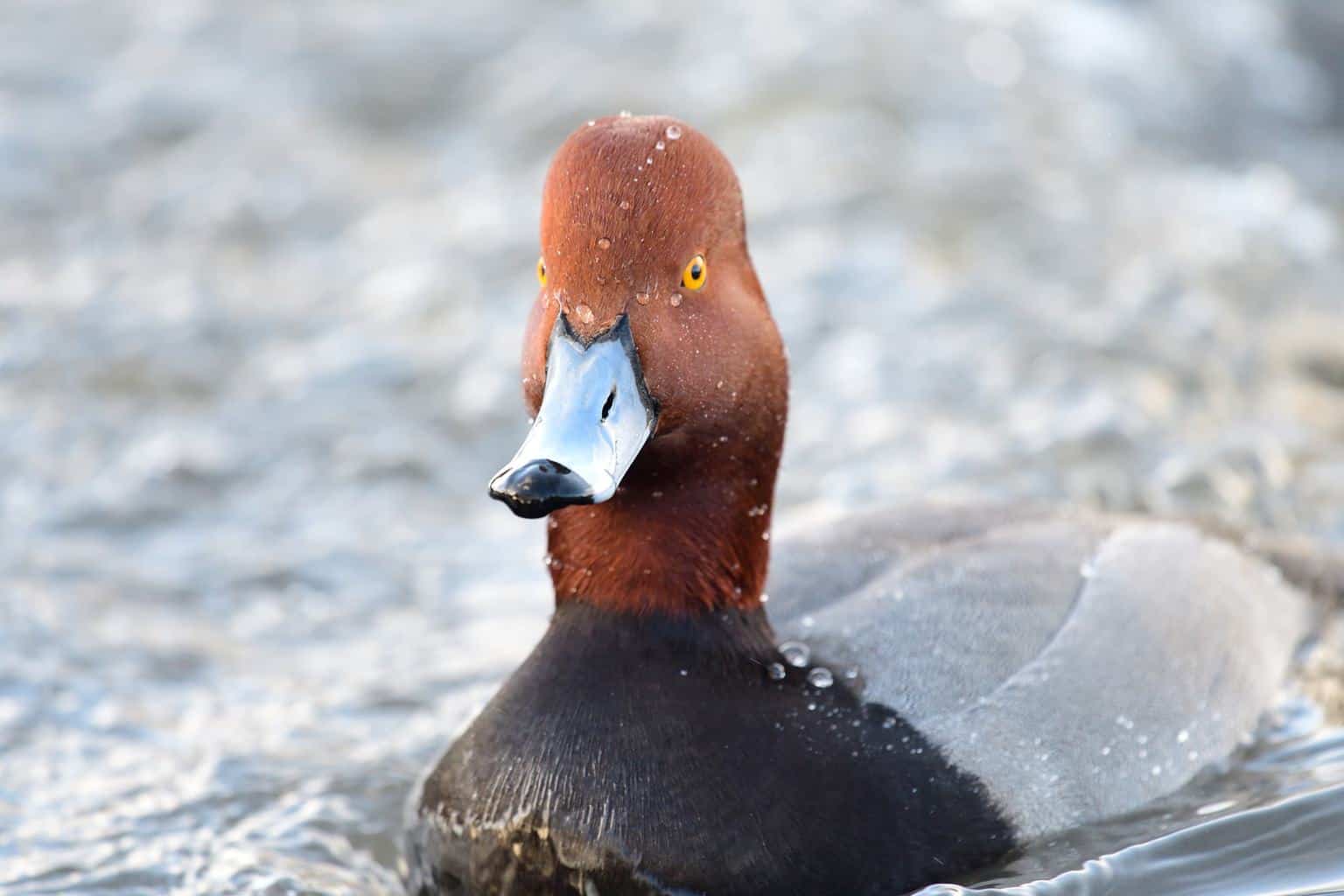
- Aythya americana
- Length: 16.5-21.3 inches
- Weight: 22.2-52.9 ounces
- Wingspan: 29.5-31.1 inches
From the category of ‘aptly named ducks,’ we have the redhead, whose drake (adult male) features a cinnamon red head against a contrasting black neck and chest.
From the black chest comes gray sides. Redhead males have light gray bills tipped in black.
Female redheads don’t sport the cinnamon head that the males do, and they have an all-brown body. The redhead female’s face is lighter than the rest of the body, and their bills are darker than males, though if you look closely you can still see a darker tip.
Coastal areas along eastern Virginia provide winter habitats for redheads, with sporadic sightings out west along larger lakes.
Redheads are most frequently spotted in protected coastal areas, often in large groups. Areas near Norfolk and Virginia Beach, including Chesapeake Bay and Back Bay National Wildlife Refuge, provide a significant number of sightings each year by eBird users.
Canvasback
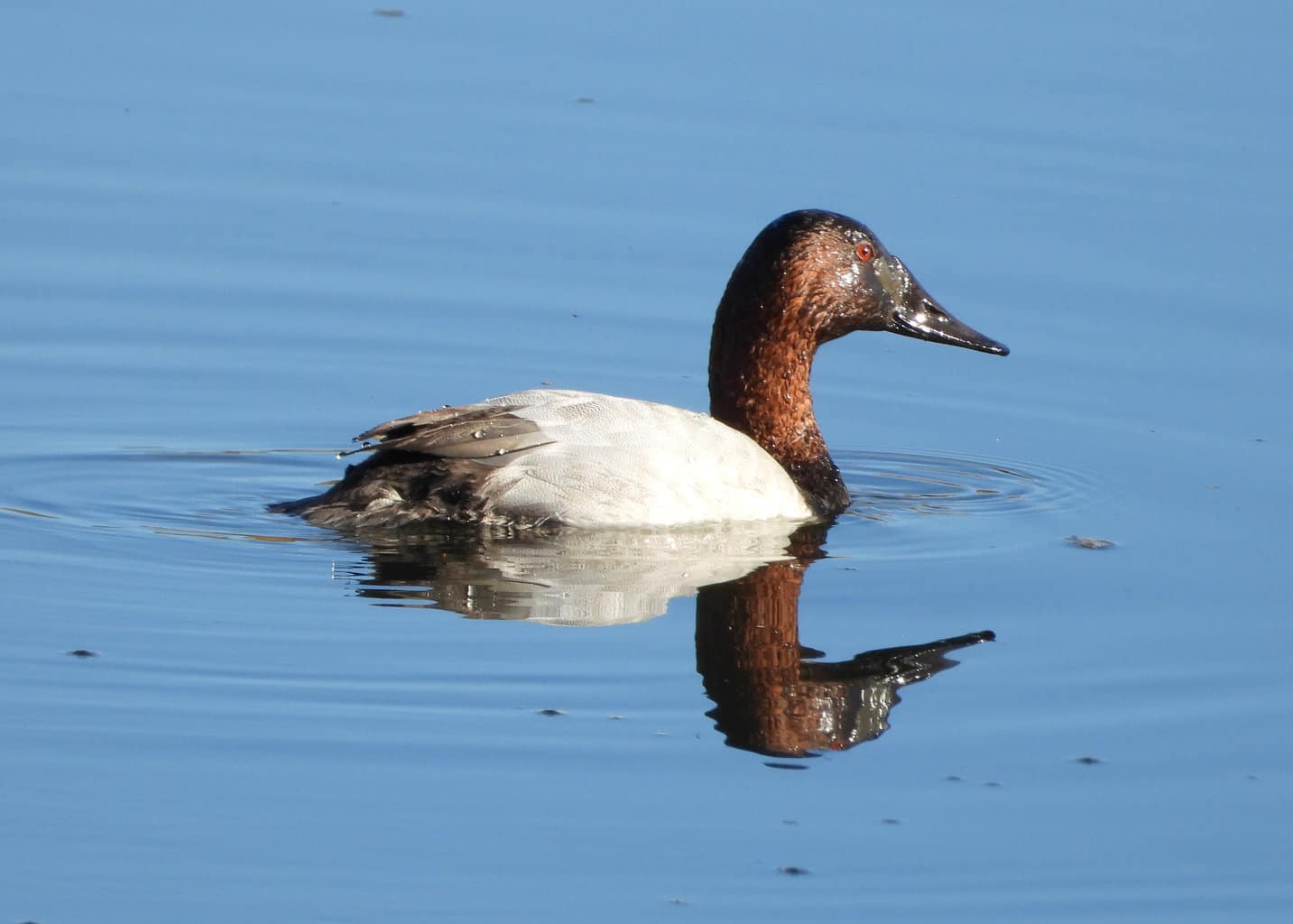
- Aythya valisineria
- Length: 18-9-22.1 inches
- Weight: 30.4-56 ounces
- Wingspan: 31.1-35 inches
Canvasbacks are the most similar-looking bird to the redhead, although if you know what to look for, a couple of easy-to-see differences can help you tell them apart.
Males have white sides in place of the redhead’s gray, with a long, sloping black bill and sharp red eyes.
The species’ head shapes are quite different from each other. The redhead has a rounded head and steep forehead, while the canvasback’s forehead slopes into a black bill in both males and females.
Canvasback females have lighter sides than redheads do.
Like redheads, canvasbacks are sometimes seen in large groups during the winter, and they can often be seen mixed in groups together on large bodies of water.
In 2023, the Potomac River was a great place to see canvasbacks in big groups at spots like Aquia Landing Park and Currioman Landing, according to eBird user reports.
Greater Scaup
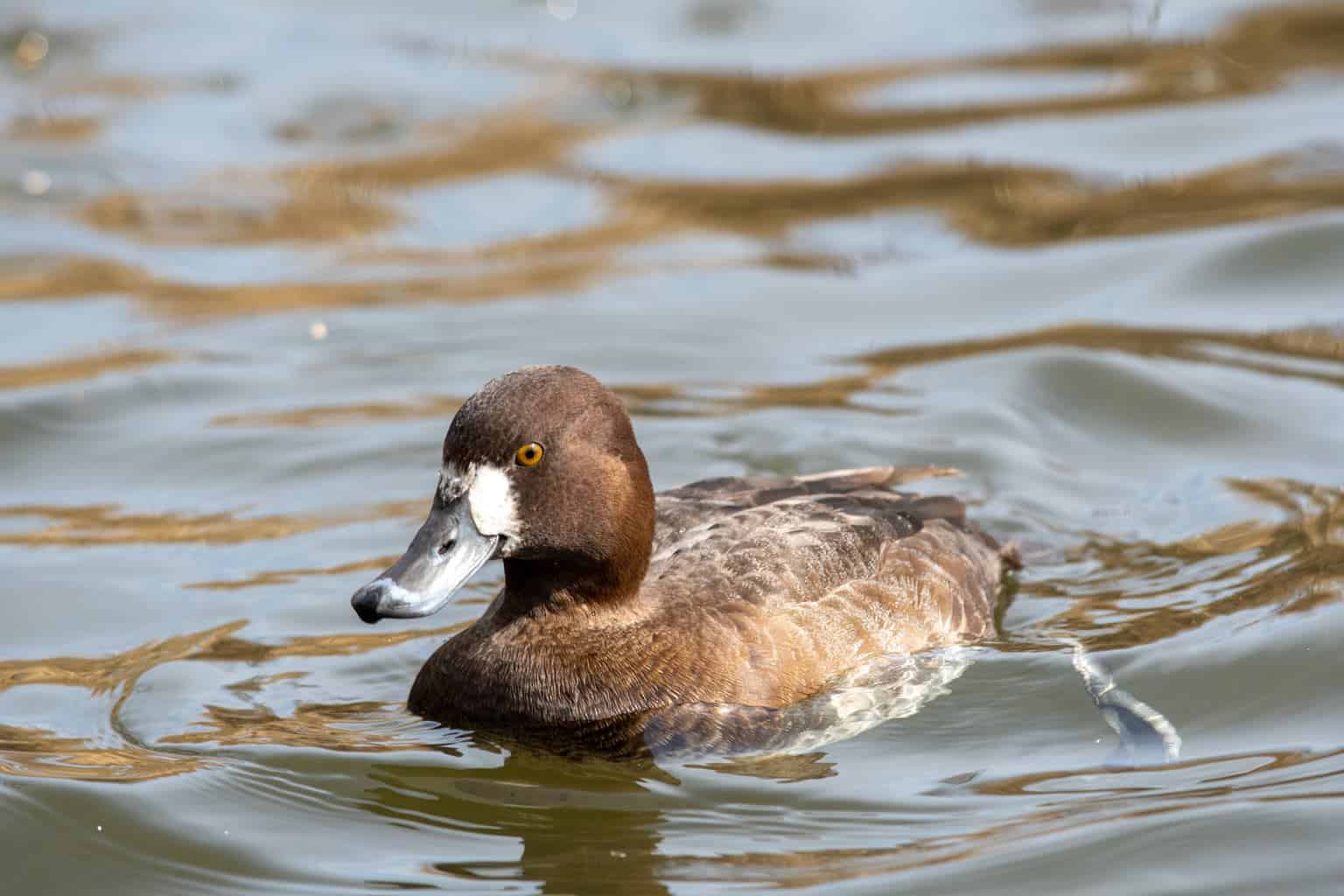
- Aythya marila
- Length: 15.3-22.1 inches
- Weight: 25.6-48 ounces
- Wingspan: 28.4-31.1 inches
There are two scaup species on our list, and they’re not the easiest birds to tell apart, so a spotting scope or photo through a telephoto lens that allows you to see the differences up close would be ideal when deciding between these two birds.
Male greater scaup have rather rounded heads, with white sides and gray patterned backs. Their heads are black, with an iridescent green shine in good lighting. They have yellow eyes and gray bills tipped in a little black point.
Females are brown all over with yellow eyes and a large gray bill that’s surrounded by a thick white ring.
Greater scaup are most frequently seen along the coast, but inland sightings are not impossible in Virginia. Scaup are winter visitors to the Old Dominion coasts.
Lesser Scaup
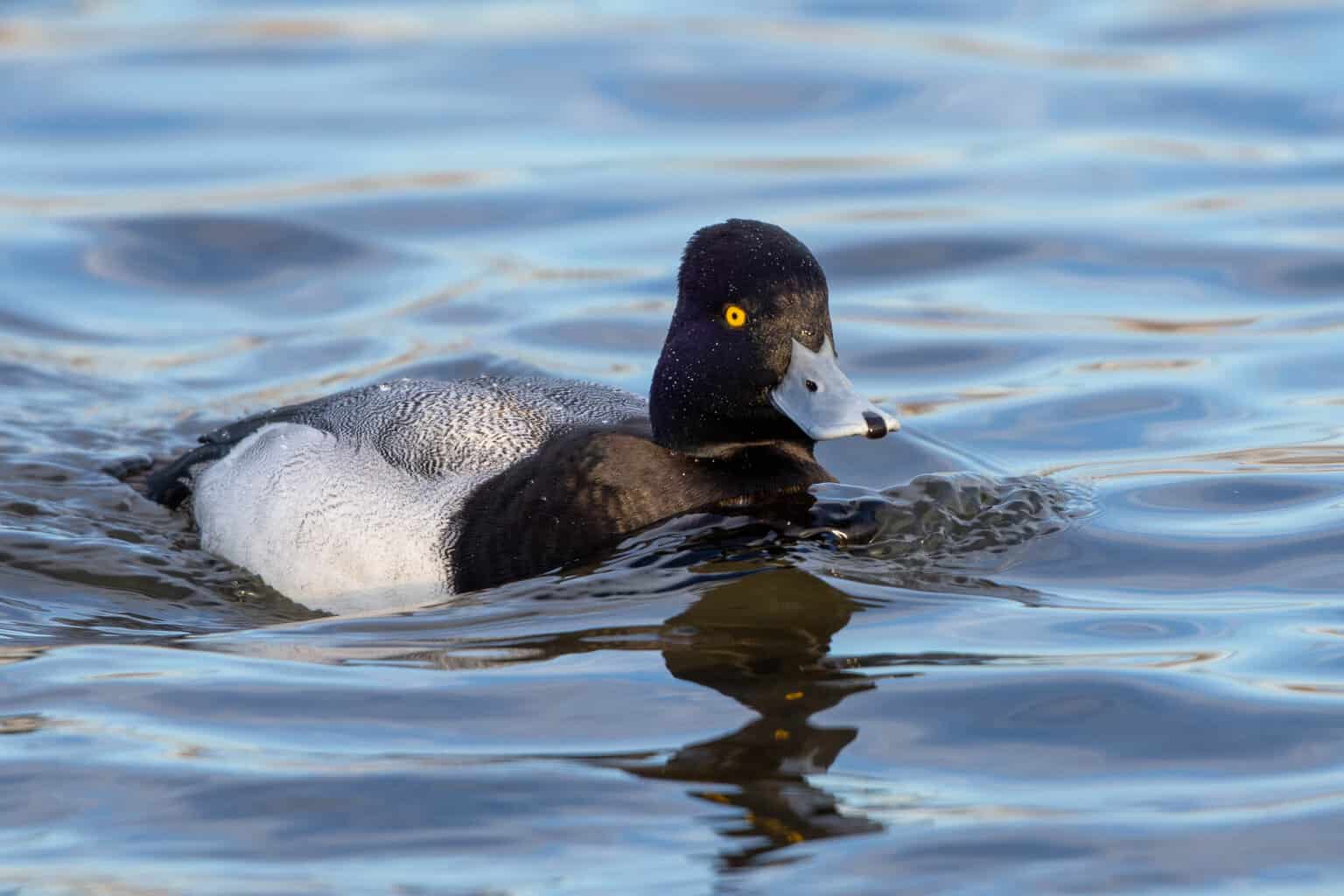
- Aythya affinis
- Length: 15.3-18.1 inches
- Weight: 16-38.4 ounces
- Wingspan: 26.8-30.7 inches
The most obvious difference between lesser and greater scaup isn’t always that obvious, especially when observing a diving duck from afar out on the ocean.
Lesser scaup have skinnier, less rounded heads than greater scaup, with a peak at the top. Males’ black heads also won’t have green iridescence on the head, instead showing purple in perfect light.
Both females and males have very similar coloring and patterns to their relatives. Males have very similar black, white, and gray coloring, and females are deep brown with a white ring around a gray bill.
For some other little things to look for when picking between the two birds, check out this guide from the National Audubon Society.
Like greater scaup, lesser scaup are winter residents of Virginia’s coasts and inland waters.
While they’re most commonly thought of as open-water ducks, lesser scaup are more likely to be seen on inland lakes, marshes, agricultural fields, and ponds than greater scaup are.
Ring-necked Duck
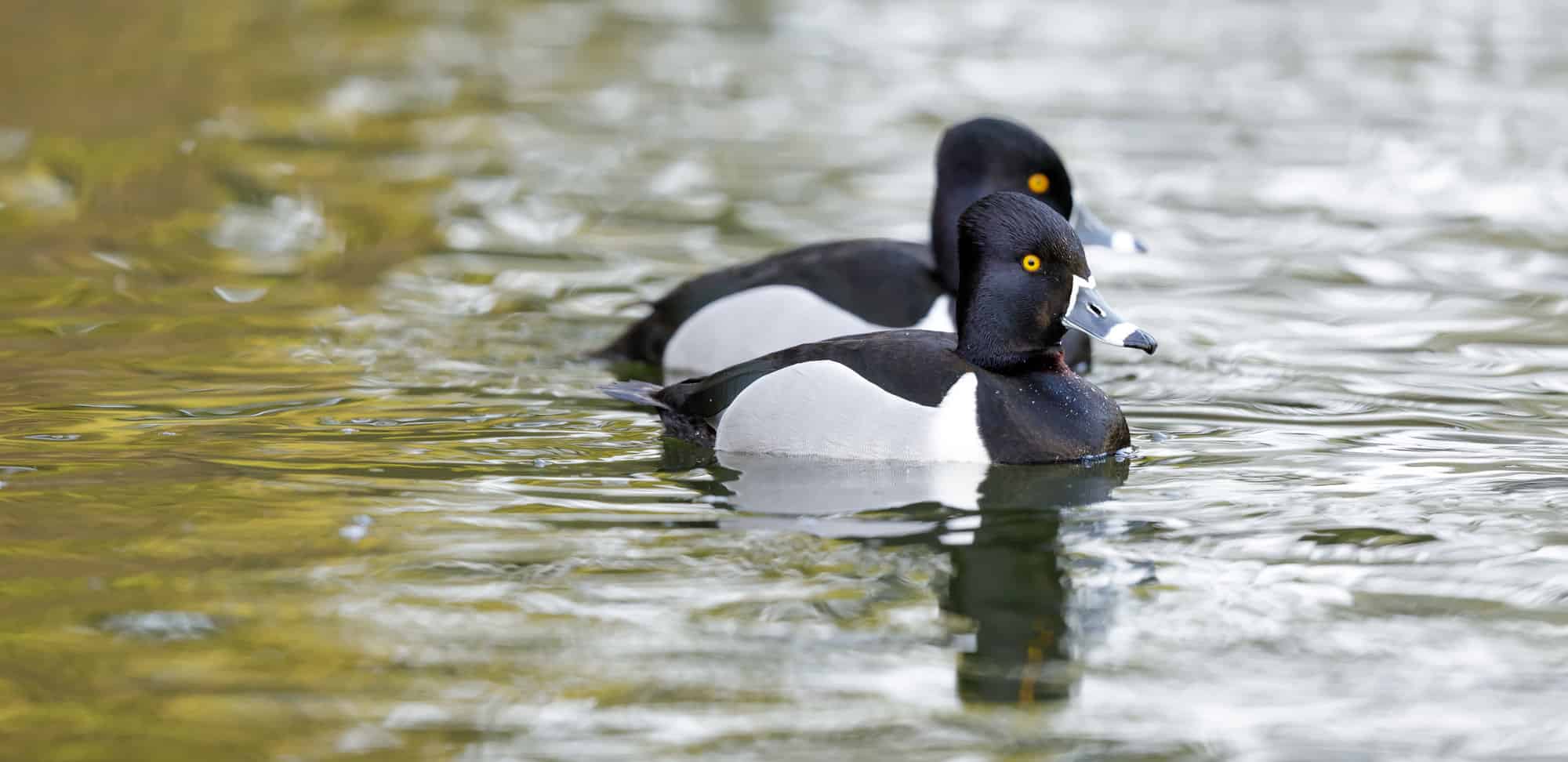
- Aythya collaris
- Length: 15.3-18.1 inches
- Weight: 17.3-32.1 ounces
- Wingspan: 24.4-24.8 inches
Ring-necked drakes are sharp ducks in their breeding plumage, with jet-black heads and chests, yellow eyes, and a gray bill with a black tip and white ring around the exterior.
In non-breeding plumage, their crisp gray sides will fade to a dirtied-looking color and the bill ring will not be as crisp, but if you know their breeding plumage patterns and body shape, you’ll still be able to recognize them.
Females have brown sides and eyes that stick out against a dull gray face. Their gray bills are similar to the males’ with a black tip and a white ring just in front.
While many other diving ducks are primarily sea-going birds, ring-necked ducks are frequently seen on smaller lakes, ponds, and marshes in winter and during migration periods, even those around big cities.
They can be found across the state outside of the summer breeding months.
Common Goldeneye
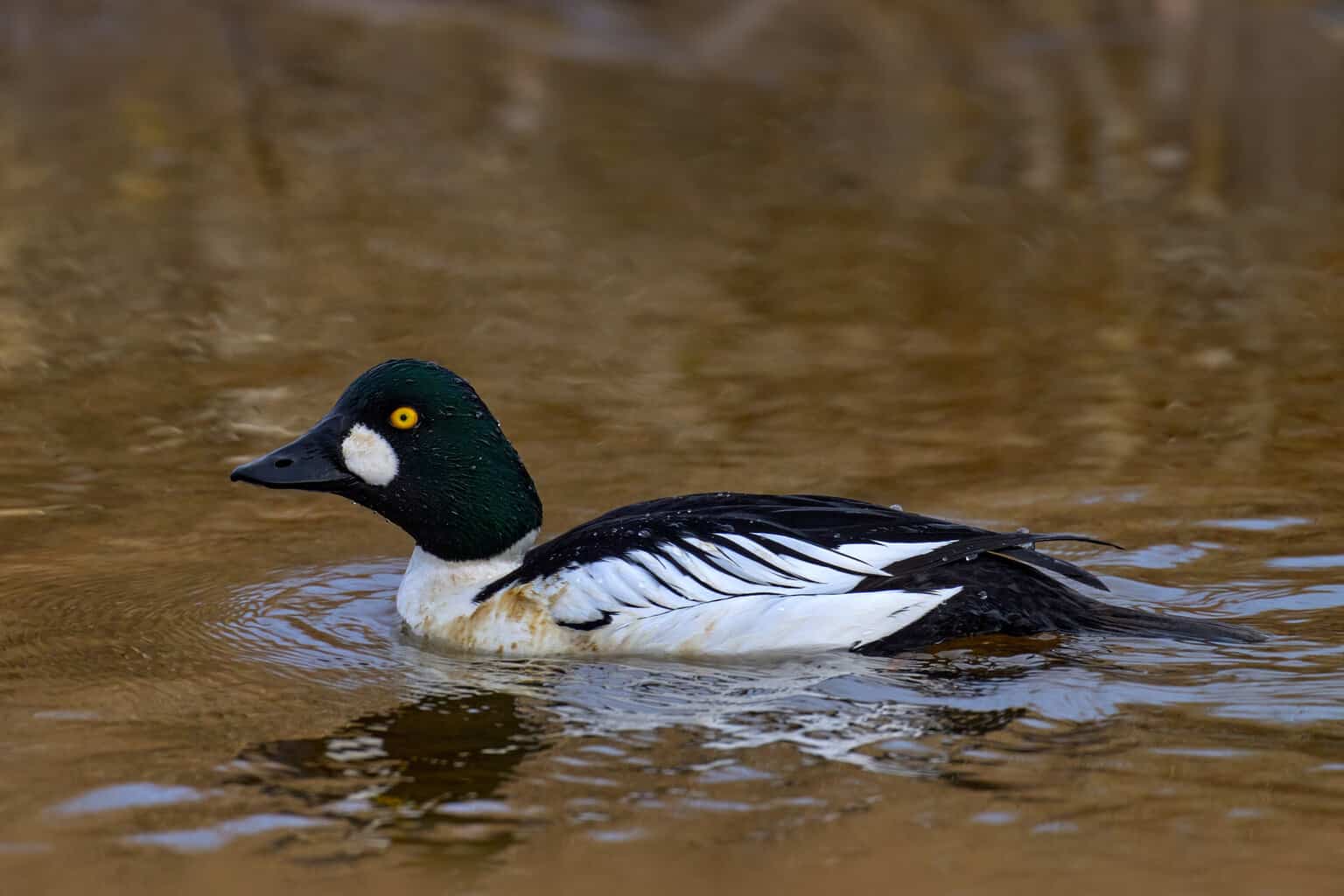
- Bucephala clangula
- Length: 15.8-20.1 inches
- Weight: 21.2-45.9 ounces
- Wingspan: 30.3-32.7 inches
The common goldeneye is a northern breeder, mostly of Canada, whose range just peaks into the United States in places like Minnesota, Michigan, Montana, and Maine, among a few other spots.
Their winter range reaches Virginia, mostly in areas on or near the coast, though there are yearly sightings on inland lakes and rivers.
Males have iridescent green heads, yellow eyes, and a white circular facial patch right in front of a black bill. Their bodies are white on the bottom through the chest and neck, with black on top and white barring on the sides where the two colors meet.
Females are mostly gray intermixed with some white along the wings, which, along with the birds’ backs, are a darker shade than their sides. They have yellow eyes and all-brown heads that contrast sharply with the gray and white of the body.
Their black bills are tipped in an orangish-yellow.
Bufflehead
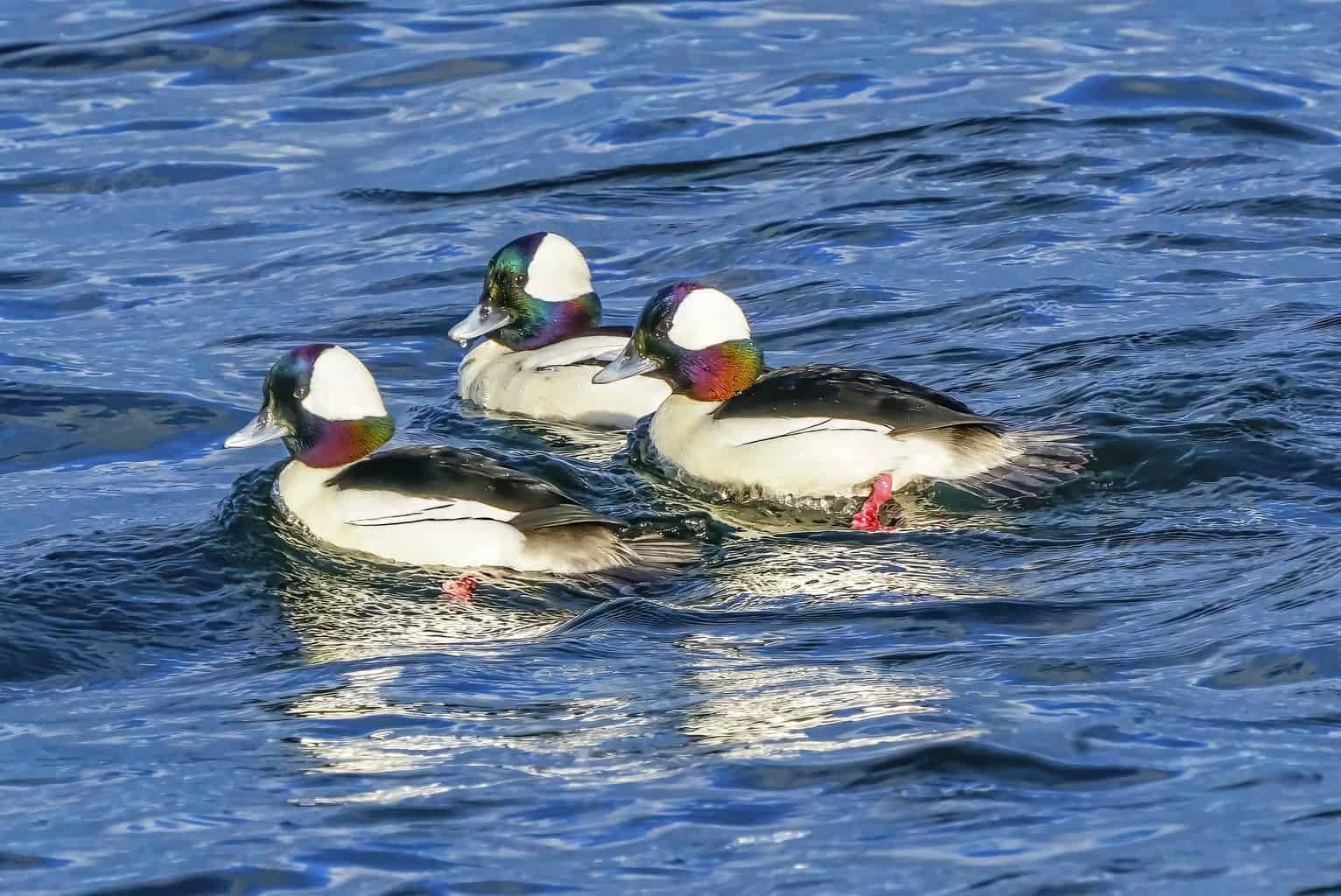
- Bucephala albeola
- Length: 12.6-15.8 inches
- Weight: 9.6-22.4 ounces
- Wingspan: 21.6 inches
Buffleheads are one of the smallest diving ducks in North America, as well as one of the most distinct and recognizable.
Males have white and black bodies, with mostly dark heads of iridescent blue, purple, and green hues. A big chunk of the colorful head is taken out, with the space occupied by crisp, clean white color.
Females are mostly grayish-brown throughout the body, with a head that’s more brown than gray. On either side of the face is a white smudge just behind the eye.
Buffleheads are common winter visitors to Virginia and surrounding waterways. While they’re most frequently spotted on bays off the ocean, eBird users frequently report them on areas like the James River, Potomac River, and other inland lakes and rivers.
Ruddy Duck
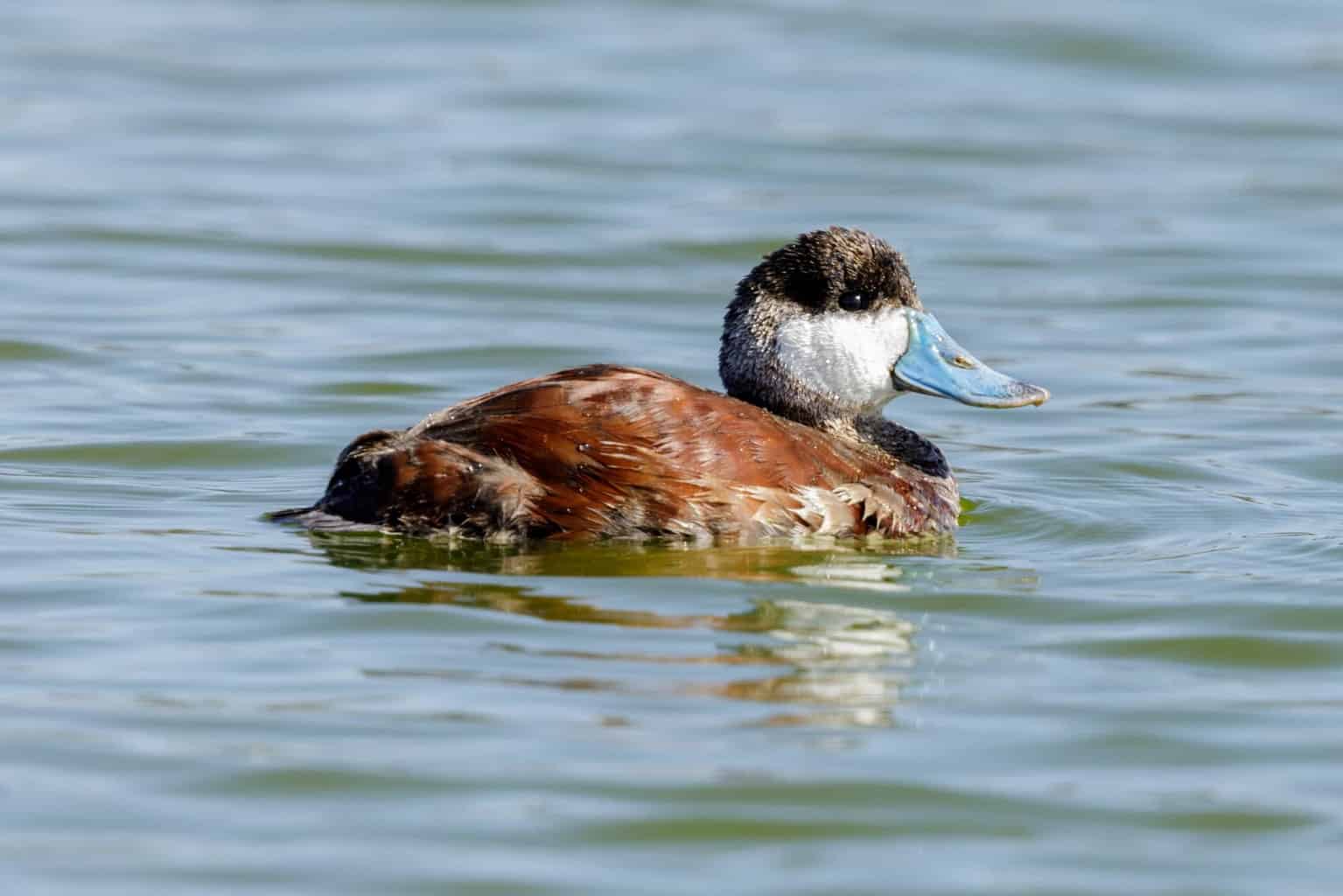
- Oxyura jamaicensis
- Length: 13.8-16.9 inches
- Weight: 10.6-30 ounces
- Wingspan: 22.1-24.4 inches
Another entry onto the list of small diving ducks is the little ruddy duck, a breeding resident of the western United States. Each winter, many of them make a cross-country trek to winter along the coasts, including those bordering Virginia.
In their breeding plumage, ruddy duck males are a sight to behold from tail to bill. Their bodies are a beautiful shade of brown, flanked on one side by a stiff black tail and on the other by a head that’s half black and half white, with a baby blue bill.
Ruddy ducks undergo a serious transformation outside of the breeding months, however, with their colors fading to dull browns. They’re still identifiable birds, with brown bodies and the same facial pattern and bill shape, but without such striking colors.
Females are brown all over, with a darker cap and dark line that runs parallel below the cap.
Bays and rivers near the coast provide the potential for ruddy duck sightings during migration and winter.
Long-tailed Duck
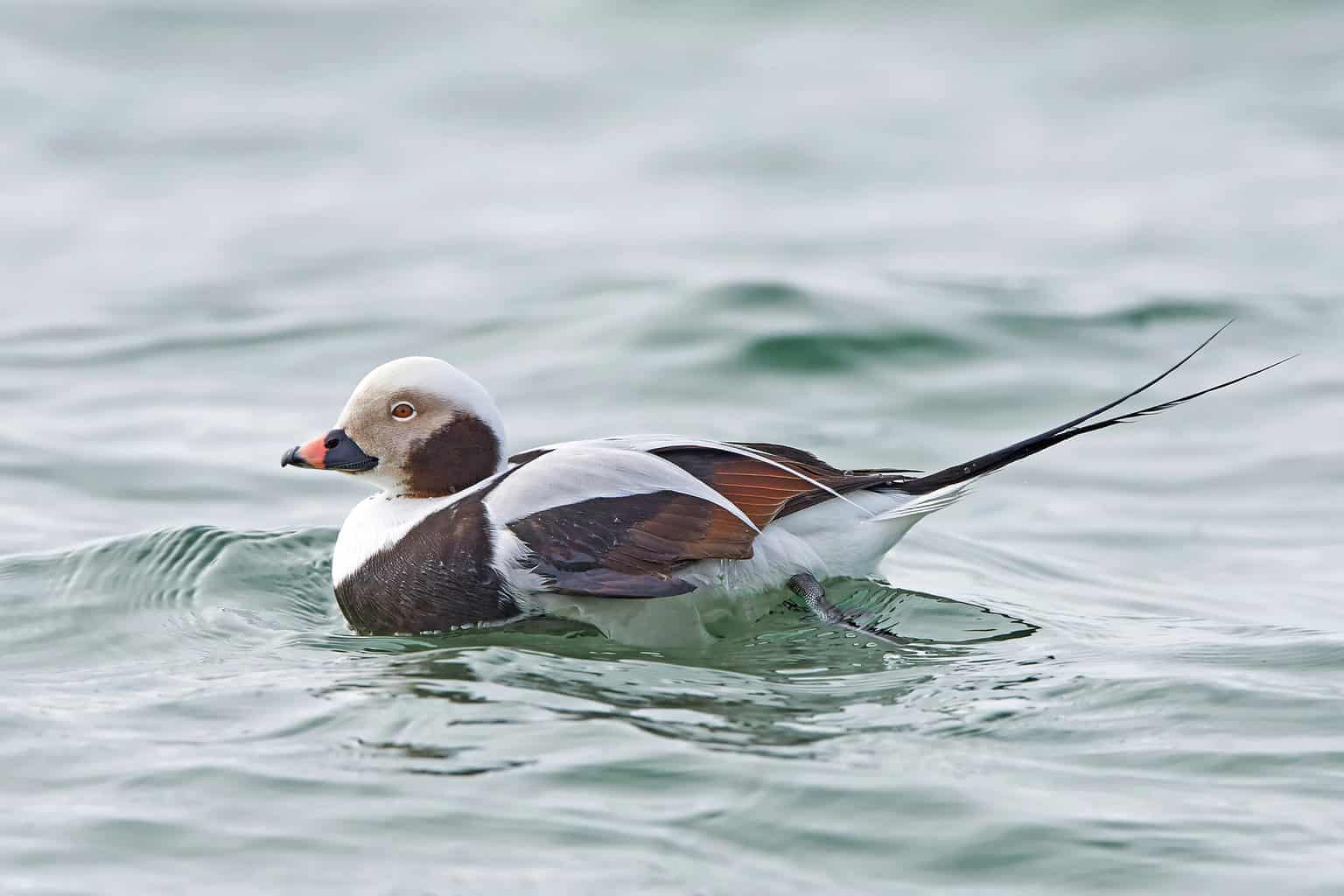
- Clangula hyemalis
- Length: 15.8-18.5 inches
- Weight: 22.9-38.8 ounces
- Wingspan: 27.9-28.4 inches
Long-tailed ducks are not common migrants to Virginia, but the southernmost stretch of their winter range does extend along the coast to Chesapeake Bay and surrounding areas.
Like ruddy ducks, long-tailed ducks undergo a notable plumage transformation each year. In breeding plumage, males are mostly dark on the face with a white patch around the eye. In non-breeding plumage, they have white caps, tan faces, and black patches around the back of the face.
At all times of year, males’ long tails are the standout, but that’s not the case for females.
Females’ nonbreeding pattern is mostly brown on the body, with a white head that looks dirty from brown smudging, most notably on the cheek.
Harlequin Duck
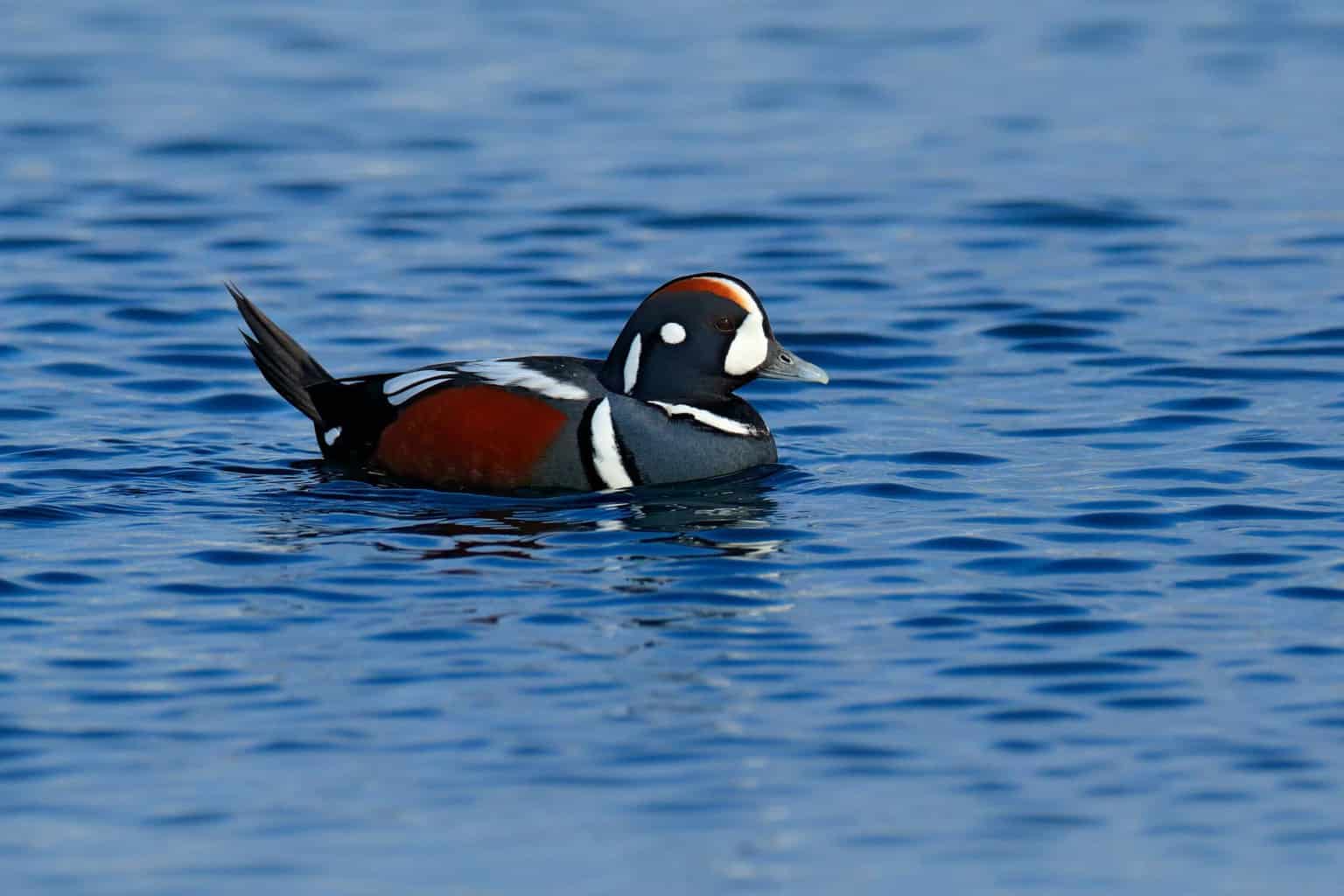
- Histrionicus histrionicus
- Length: 13.4-18.1 inches
- Weight: 17.3-26.8 ounces
- Wingspan: 22.1-26 inches
Harlequin ducks are also rare visitors as far south as Virginia, preferring rocky shores along the northern coasts of the Atlantic, the majority in Maine, which is estimated to hold over half the eastern population in the winter months, according to All About Birds.
Still, it’s possible to see one make its way to Virginia, such as the regular visitor reported by eBird users over the winters of 2022 and 2023 at Rudee Inlet, near Virginia Beach.
In the breeding season, the small harlequin duck’s colors are like no other, with beautifully defined patterns of slate gray, deep blue, chestnut brown, and crisp white. Nonbreeding males, however, feature more subdued patterns and colors, with more brown than blue.
Females are brown all over except for a couple of white facial patches, one between the bill and eye and the other toward the back of the head.
Common Merganser
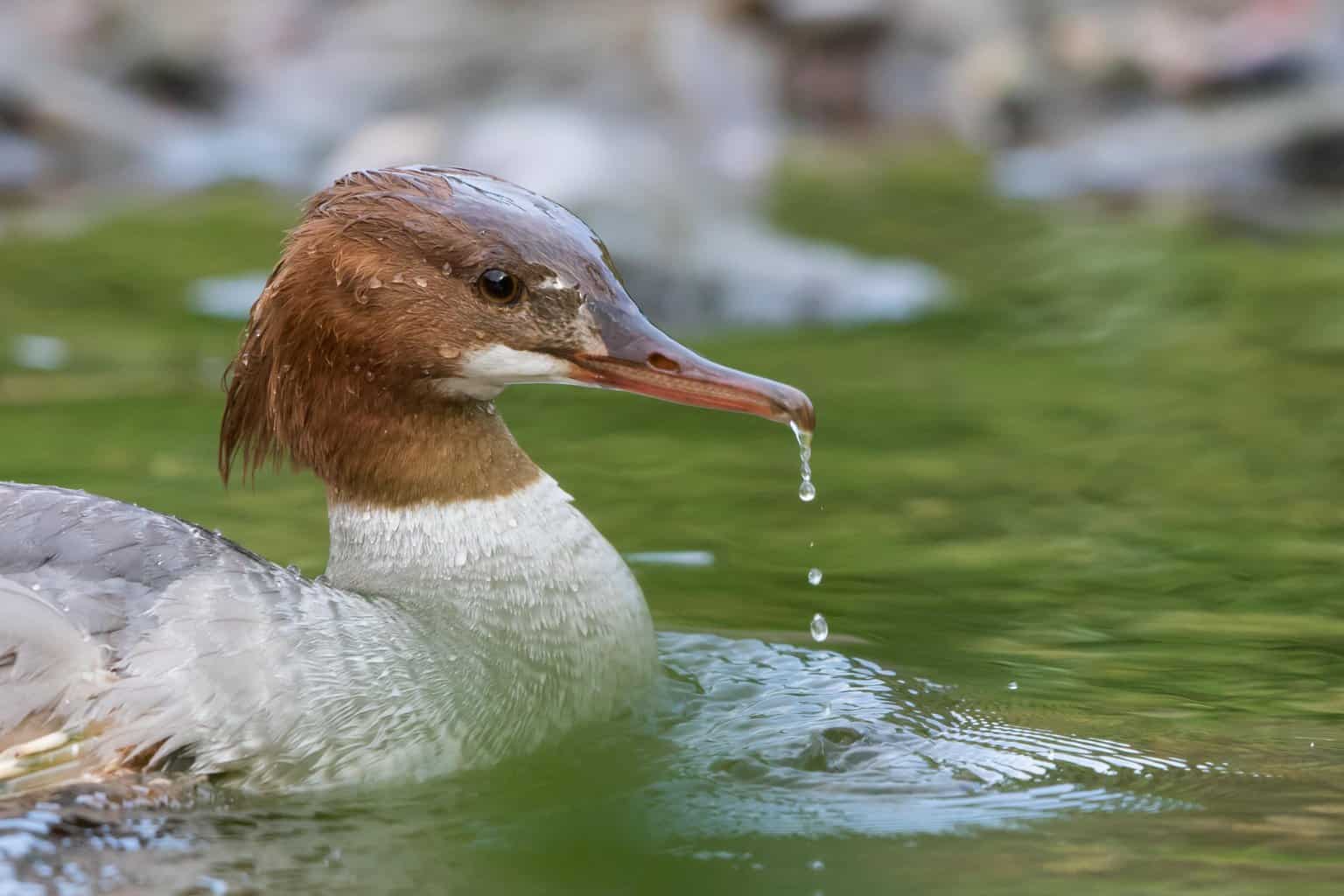
- Mergus merganser
- Length: 21.3-27.9 inches
- Weight: 31.8-76.2 ounces
- Wingspan: 33.9 inches
Frequently seen year-round in the northeast, common mergansers are another bird whose winter range just reaches Virginia.
While they are sometimes seen in saltwater, they’re less commonly spotted there than many of the other diving ducks listed here.
Among the water bodies they’re spotted on during non-breeding months by eBird users is the Roanoke River in western Virginia.
They’re large, sleek diving ducks with crisp color patterns. Males have green heads that meet a mostly white body at a clean neckline, while females’ gray bodies contrast against a cinnamon red head.
Both males and females have red bills. Females have a white patch near the chin, which will be notable when comparing them to the next bird on this list.
Red-breasted Merganser
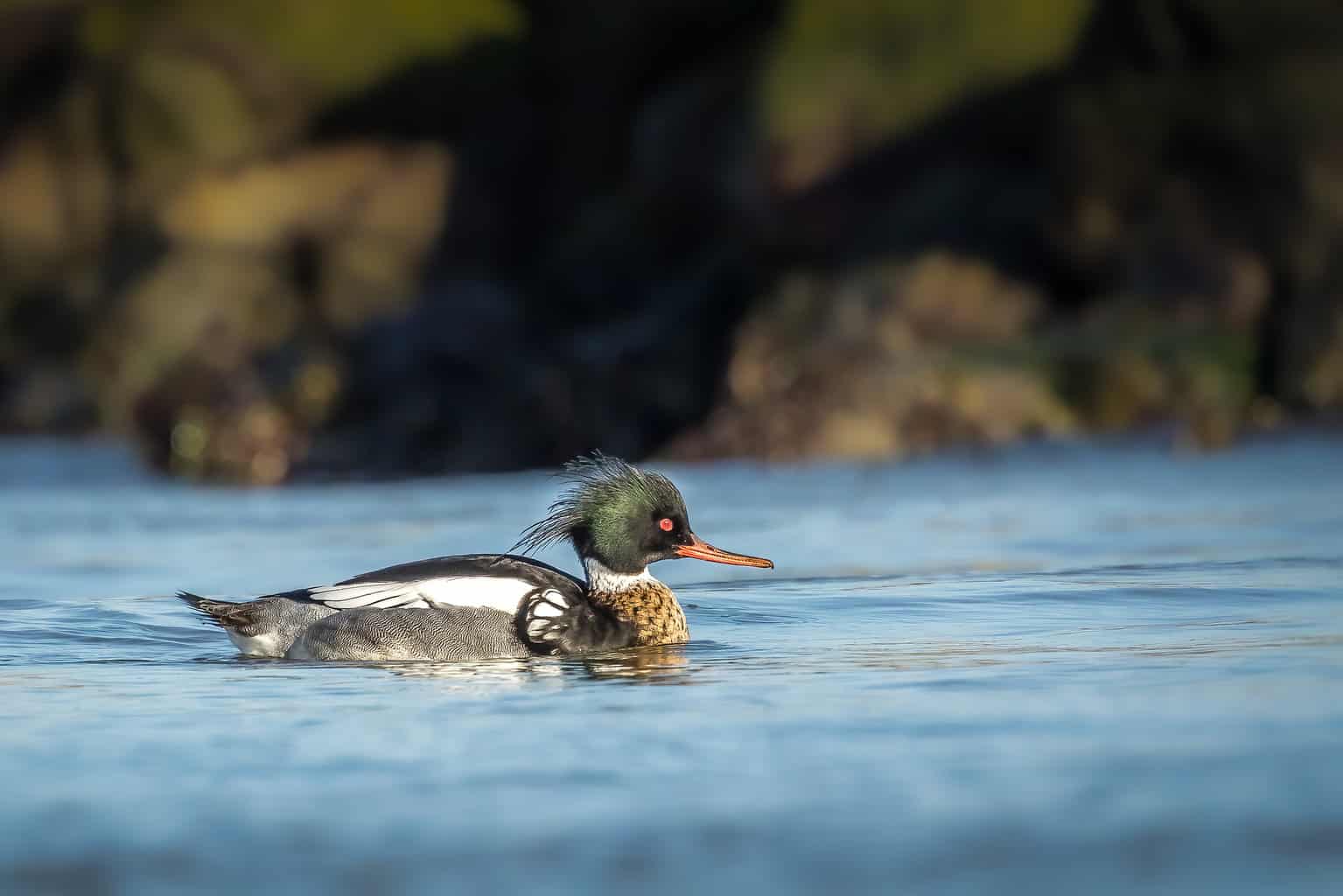
- Mergus serrator
- Length: 20.1-25.2 inches
- Weight: 28.2-47.6 ounces
- Wingspan: 26-29.1 inches
Red-breasted merganser females look similar to common merganser females, with mostly gray bodies and red heads. Red-breasted females have a more gray chest and neck than common mergansers and lack the white chin patch.
The males look fairly similar as well, but they have a couple more visible differences that can be seen from afar. For starters, red-breasted mergansers have the species’ namesake red breast, as well as a thick white ring around the middle of the neck, red eyes, and sides of gray and white.
Red-breasted mergansers are more common along the Virginia coast than common mergansers, with a winter range that goes as far south as the Florida Keys.
Sightings dot the coast through the winter months, as they’re most frequently seen on open water, but like the common mergansers, they’re also seen inland on rivers and large lakes from time to time.
Hooded Merganser
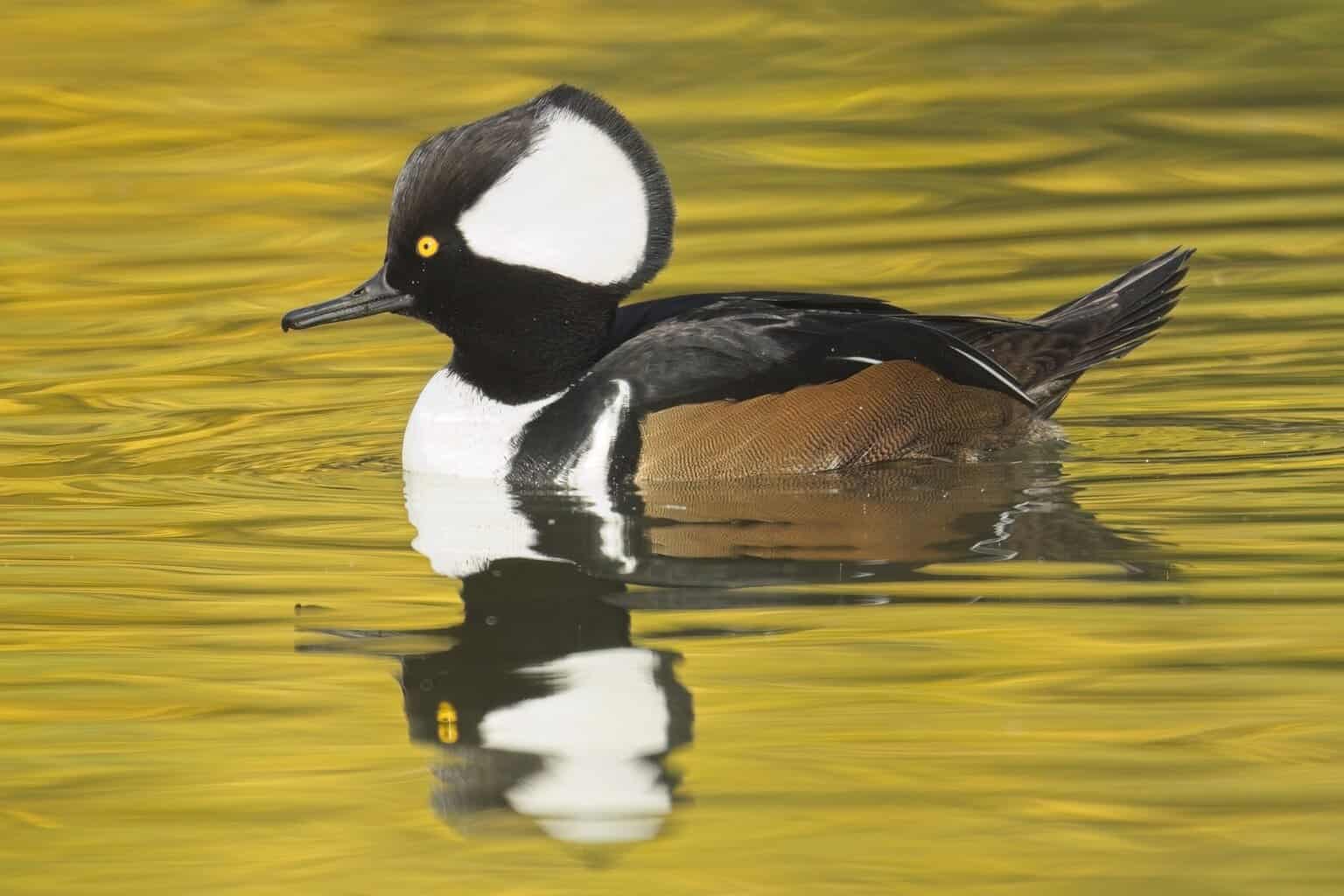
- Lophodytes cucullatus
- Length: 15.8-19.3 inches
- Weight: 16-31 ounces
- Wingspan: 23.6-26 inches
The last two mergansers were not year-round residents, but the hooded merganser is a resident nester and year-round sight across Virginia.
Hooded mergansers are cavity nesters, so during breeding you’ll need to look near water bodies where they’re likely to find nesting cover and adequate food.
This doesn’t exactly sound like the saltwater coasts, so you’re most likely to see them along inland rivers, streams, and lakes during the summer months. But as fall rolls around, many will head to protected areas along the coast.
Male hooded mergansers have brown flanks with white and black chests, but their large crested head stands out above anything. When on full display, the head is three-fourths black, with a large pie-slice worth of white taken out of the back.
That crest is not always on full display, however, as it can sometimes lay flat against the back of the bird’s head.
Females also have a similar-shaped crest, although it’s brown compared to the sharp blacks and whites on the male. It’s generally a redder brown than the rest of the female’s brown body.
Common Eider
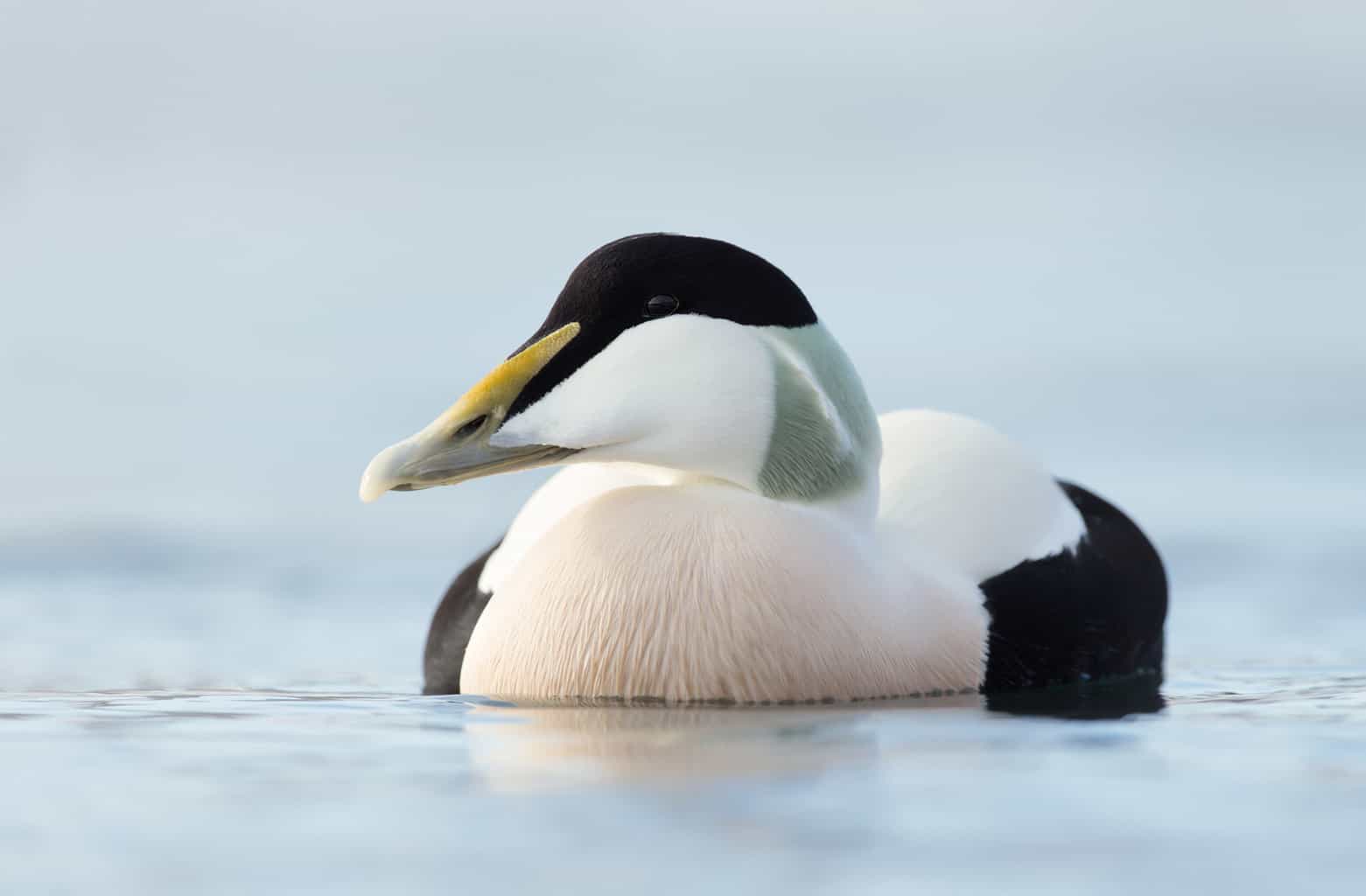
- Somateria mollissima
- Length: 19.7-28 inches
- Weight: 45.9-92.1 ounces
- Wingspan: 37.4-38.6 inches
Common eiders are most common in northern waters, but some make their way south in the winter, with the coastlines of Virginia and the Carolinas providing some opportunities for sightings.
If you’re hoping to see an eider, keep your ear to the birdwatching pulse, especially around the southern Chesapeake Bay area, so that when one is spotted, you’re able to jump on it and head to the reported area.
Eiders are exclusively coastal ducks, and they stick out pretty well, with long, sloping foreheads and bills and thick bodies.
Males are mostly black and white, while females are reddish brown with black barring all around.
King Eider
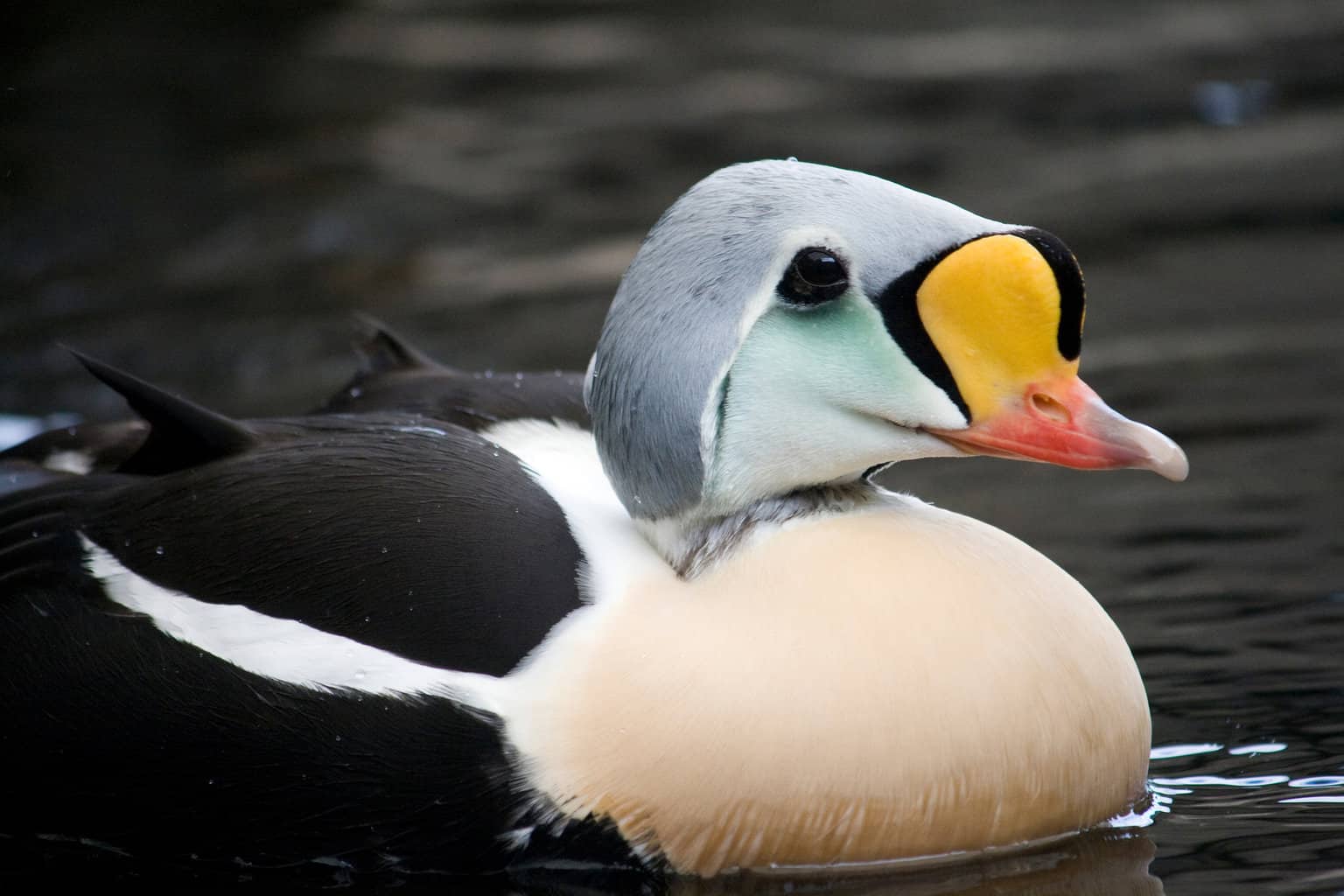
- Somateria spectabilis
- Length: 18.1-25.2 inches
- Weight: 42.3-74 ounces
- Wingspan: 35-40.2 inches
(Measurements courtesy of the University of Michigan’s BioKids)
You can put king eiders in the same category as common eiders: common in their main range, but rare nonbreeding sightings in the waters around Virginia.
Like common eiders, most sightings are around the Virginia Beach and Delmarva Peninsula regions, but there might only be a bird or two spotted regularly each year. Birding social media groups, local clubs, and eBird are a couple of ways that you can keep up with what’s happening in your corner of the birding world.
Males are black and white on their large bodies, with beautiful faces of gray, green, and orange, the latter making up a large knob right above the bill.
Females are brown with large black bills and eyes. Like males, they’re large birds, with their three-plus pound bodies helping you spot them from afar if you’re lucky enough to stumble upon one.
Surf Scoter
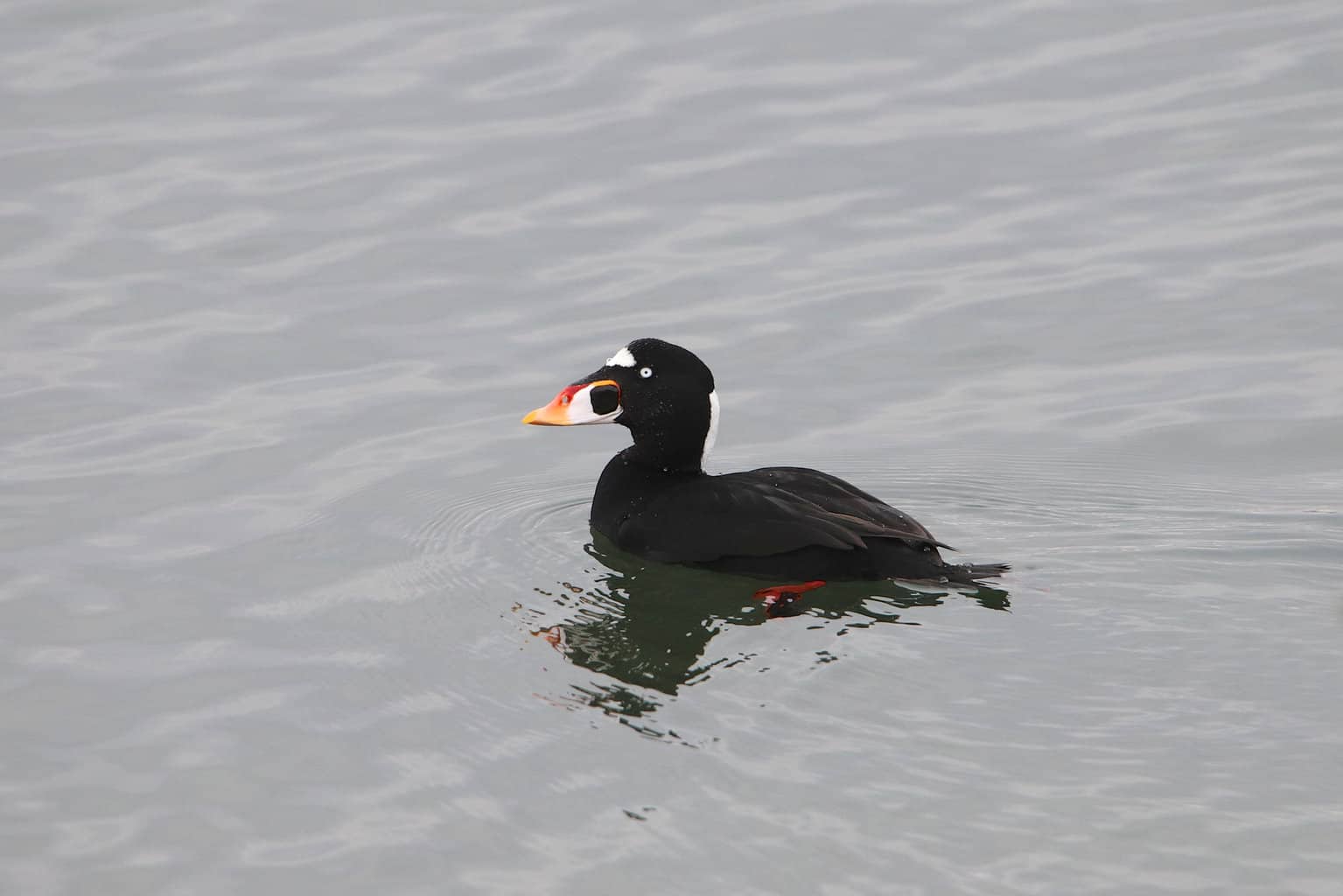
- Melanitta perspicillata
- Length: 18.9-23.6 inches
- Weight: 31.8-45.6 ounces
- Wingspan: 29.9-30.3 inches
The first of three scoter species native to the United States is the surf scoter.
They are thick-bodied sea ducks, with males all black until the neck. They have white patches on the forehead and nape, with white eyes and a bulky orange and white bill.
Females are brown all over, with black bills and two white patches on either side of the face surrounding a brown eye.
Surf scoters are seafaring ducks that are sometimes found in large groups near Virginia during the winter. For example, groups of up to 330 have been reported off Smith Island by eBird users.
Come spring, surf scoters will head north, mostly to Canada, to breed, at which time people might see them on the Great Lakes and inland throughout the Northeast as they move to breeding grounds in central Canada.
White-winged Scoter
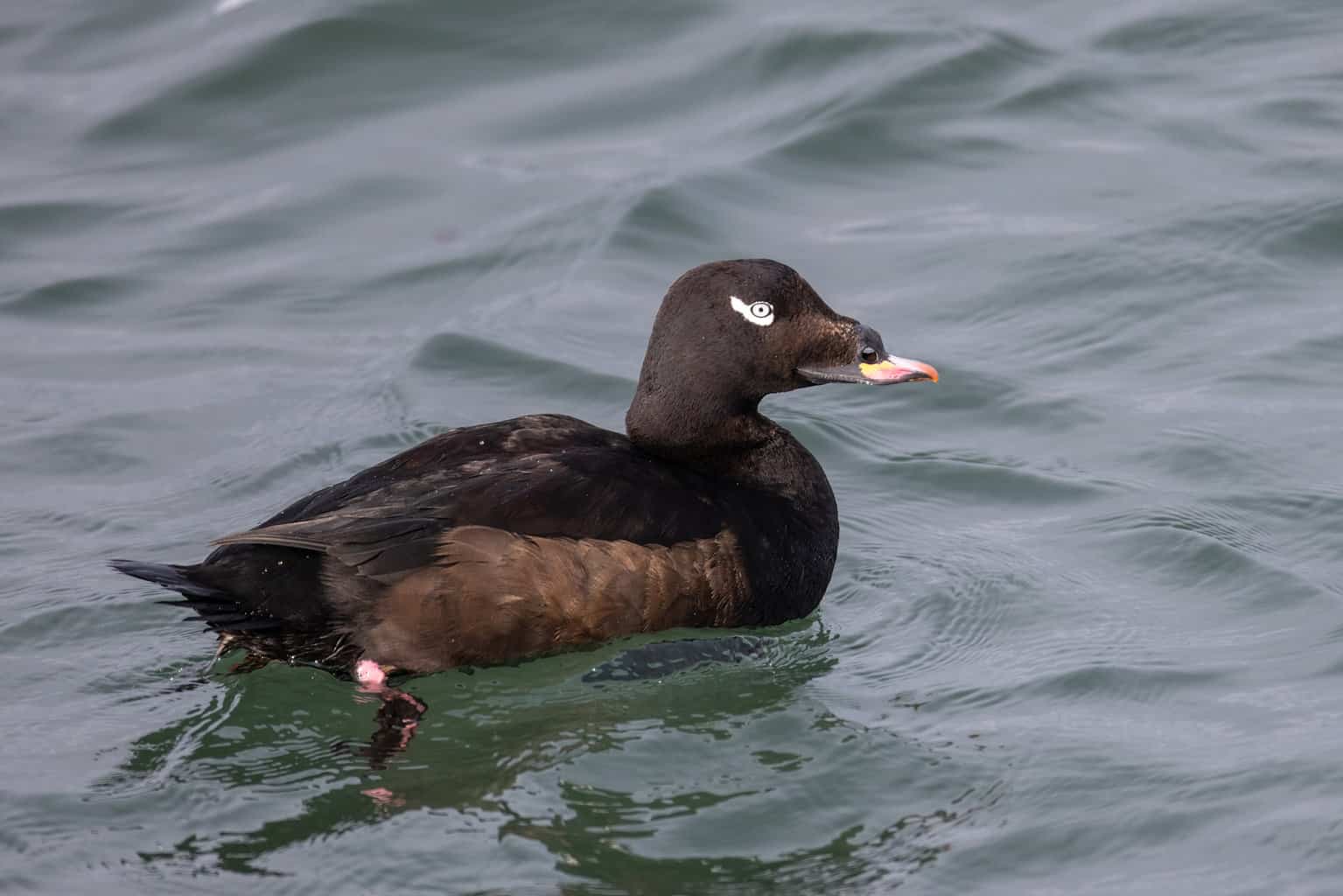
- Melanitta deglandi
- Length: 18.9-22.8 inches
- Weight: 33.5-63.5 ounces
- Wingspan: 31.5 inches
White-winged scoters are larger than surf scoters, as well as black scoters, the next bird on our list and the smallest of North America’s three scoters.
They’re also a bit rarer, though they are spotted each winter off the Virginia coast.
White-winged scoter males are mostly black. They have white on their wings that can be seen toward the back of their bodies when sitting on the water. Their faces feature an orange bill with a black knob on top, as well as a white eye with a white ring all around it.
Females feature brown plumage as opposed to the males’ black, but they also have a white wing patch, as well as two white facial patches, one on either side of the eye.
This can make them look fairly similar to female surf scoters, though surf scoters don’t have the signature white wing patch.
Black Scoter
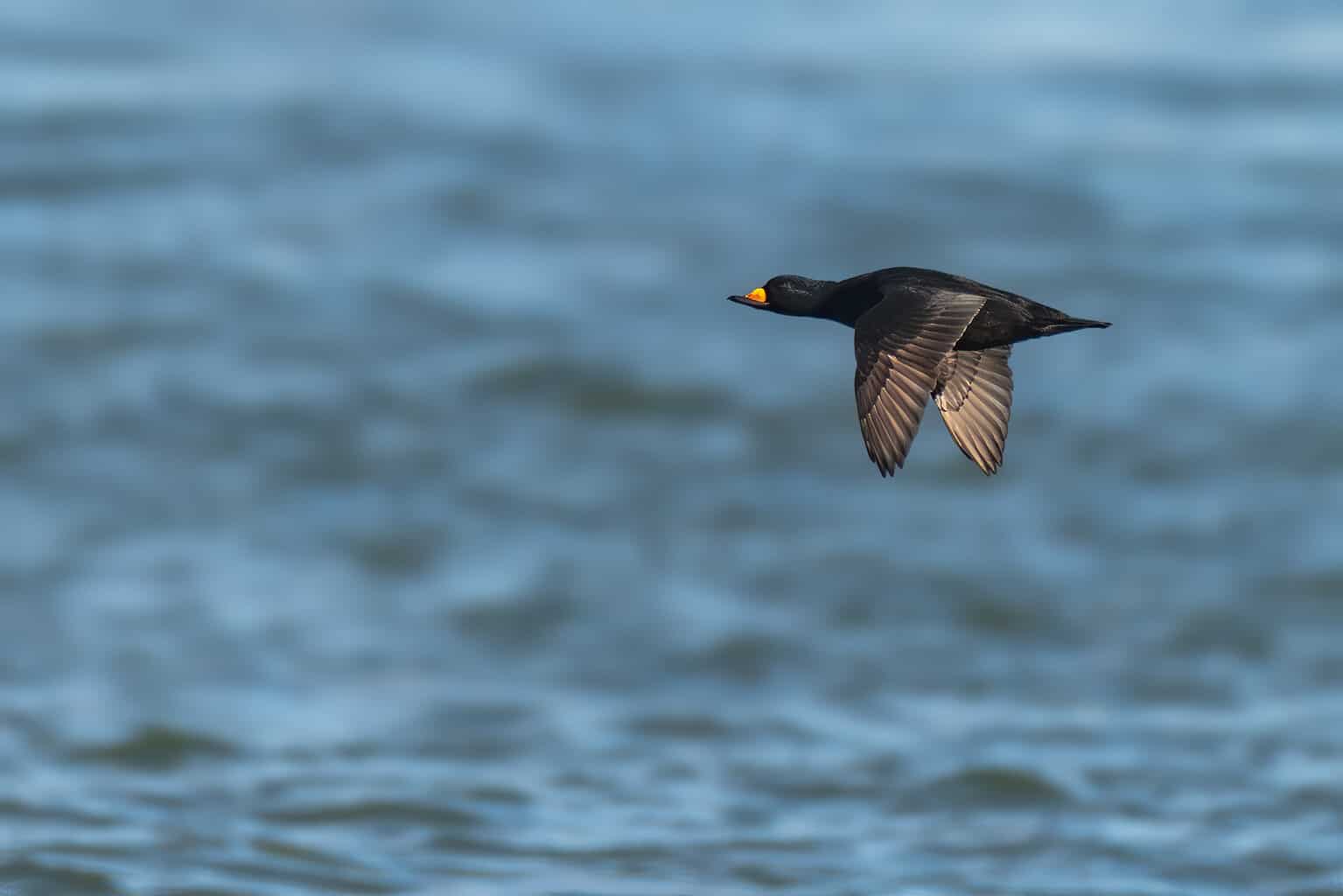
- Melanitta americana
- Length: 16.9-19.3 inches
- Weight: 30.4-38.8 ounces
- Wingspan: 27.6-28.4 inches
The smallest of the three scoters is the black scoter. Like the other two, it’s a sea-going duck that can often be seen in flocks, intermixed with other species.
Black scoters winter along the United States coasts before heading up to breeding grounds in Alaska and northeastern Canada during the breeding season.
Males are jet black from bill to tail except for a prominent yellow-orange knob at the base of their bills.
Females are mostly brown, with a face that’s lighter in color on the bottom and darker starting at the eye line.
Dabbling Ducks in Virginia
Mallard
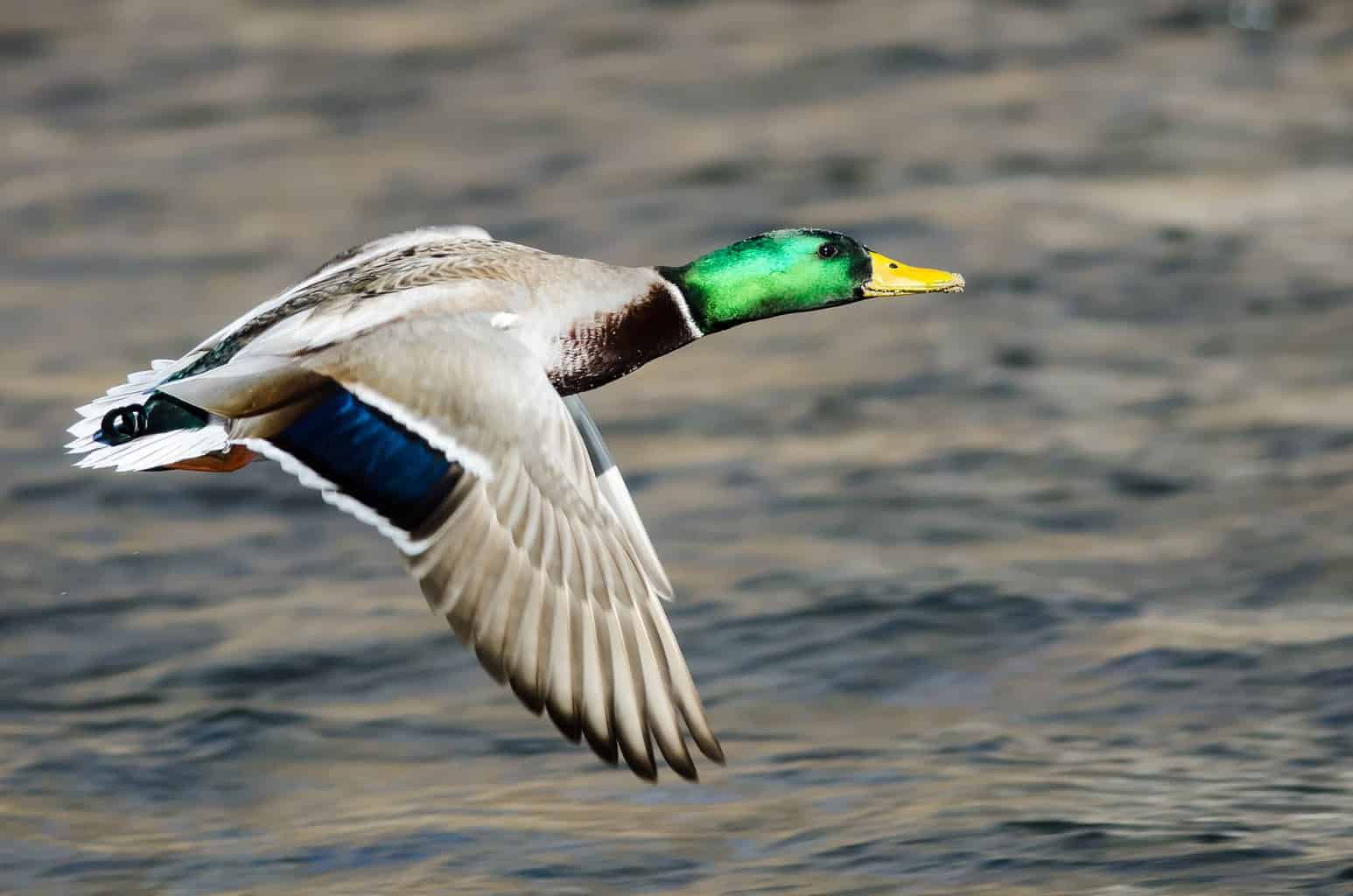
- Anas platyrhynchos
- Length: 19.7-25.6 inches
- Weight: 35.3-45.9 ounces
- Wingspan: 32.3-37.4 inches
The total 2022 mid-continent breeding population of mallards was about 7.16 million, according to the Virginia Department of Wildlife Resources Fact Sheet.
The mallard’s title as North America’s most common duck can be attributed in part to its adaptability, thriving everywhere from marshes and wetlands to places like backyard ponds, school grounds, and public parks.
Males are easily picked out of a crowd by their green heads and yellow bills, while females’ brown bodies are reminiscent of many other female dabbling ducks, with brown patterned bodies. They have gray and orange bills.
Northern Shoveler

- Spatula clypeata
- Length: 17.3-20.1 inches
- Weight: 14.1-28.9 ounces
- Wingspan: 27.2-33.1 inches
The northern shoveler isn’t the most closely related bird to mallards, but the male’s green head is probably the only one on this list that rivals the mallard.
Other than the green head, however, there isn’t much to link these two drakes together. Shovelers have yellow eyes, bodies of white, black, and chestnut brown, and a large black bill shaped like a shovel.
Females look similar to mallards as well, but once again, the bill sets them apart. Female shovelers’ bills are orange, with a shape and size bigger than any other dabbling duck.
Shoevelers are not year-round residents of Virginia, but they travel to the state every winter from northern breeding grounds.
Rivers, marshes, and lakes around major cities provide yearly opportunities to see shovelers. Often, shovelers are less skittish than other ducks, meaning a walk along a boardwalk or lake could provide an up-close sighting.
American Black Duck
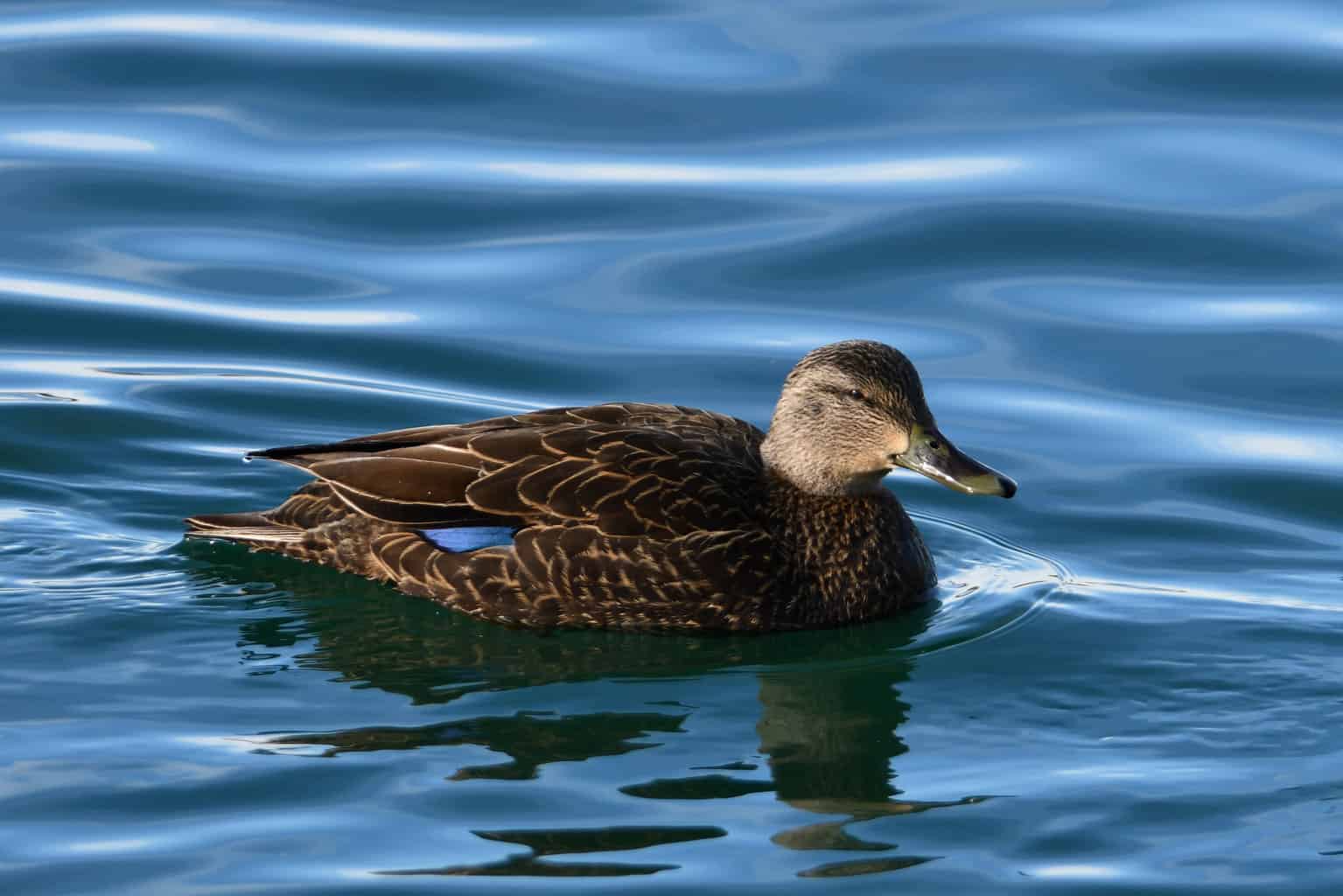
- Anas rubripes
- Length: 21.3-23.2 inches
- Weight: 25.4-57.9 ounces
- Wingspan: 34.6-37.4 inches
American black ducks are one of the more difficult ducks to tell apart from the mallard if you don’t know what to look for, and this is only amplified by the fact that they often hang around and hybridize with mallards.
One key difference to look out for is in the bill color of the birds. American black duck males look similar to female mallards, only slightly darker and with yellow bills instead of the orange and gray mix of the mallard. Female black ducks are also darker than female mallards, and they sport an olive-green bill color.
All of Virginia is a winter station for American black ducks, a species concentrated in the U.S. east of the Mississippi River. Eastern Virginia also provides year-round homes to many American black ducks.
American black ducks nest in wetlands of both the saltwater and freshwater varieties. In the winter, they may be seen in wetlands, lakes, and saltwater bays.
Gadwall
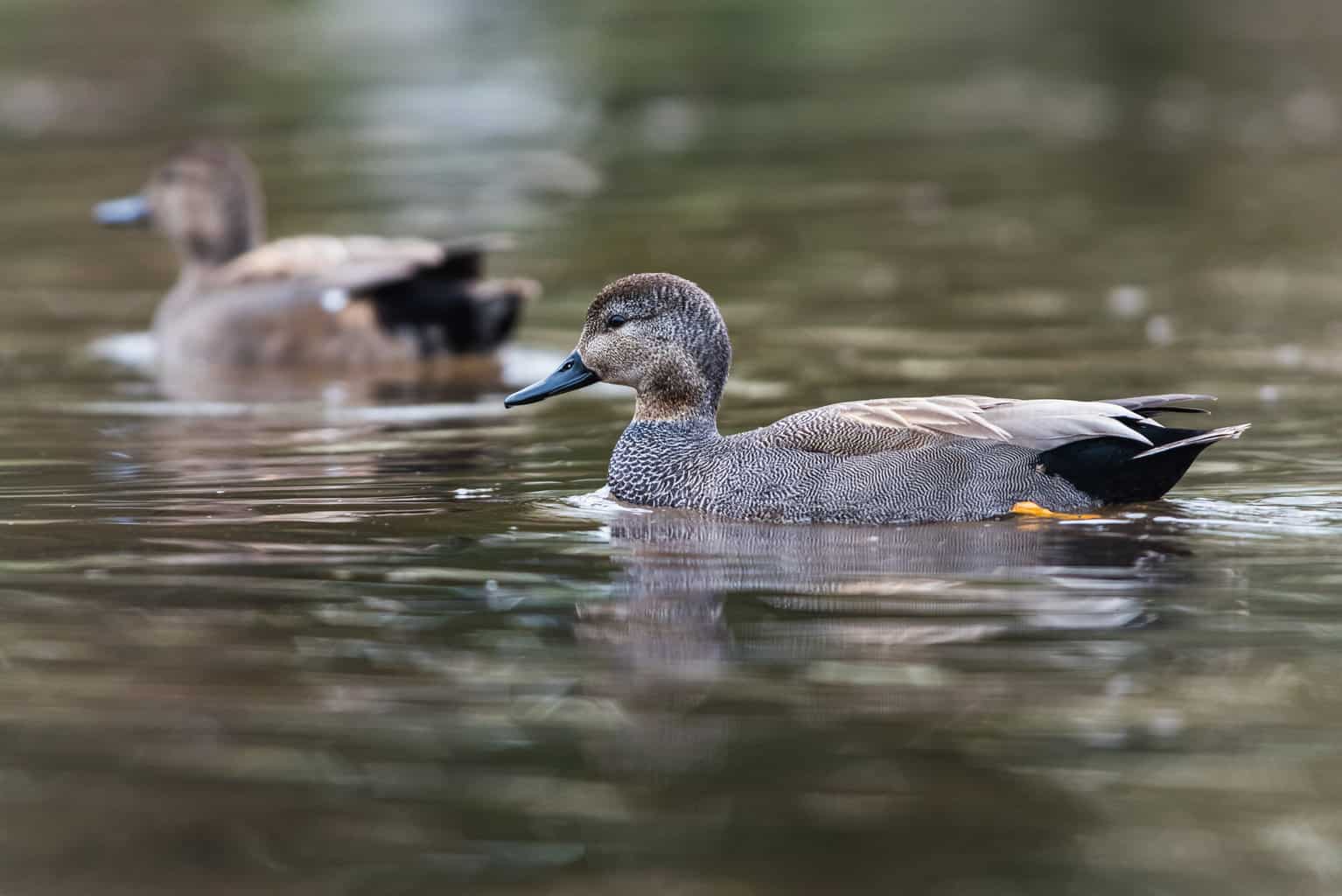
- Mareca strepera
- Length: 18.1-22.4 inches
- Weight: 17.6-44.1 ounces
- Wingspan: 33.1 inches
Mallard and gadwall females look quite alike. You can look for a thinner bill and a slightly steeper forehead on the gadwall, or you can look for the mallard’s blue shoulder patch.
Male gadwalls have black bills and brown heads, with mostly gray bodies. They aren’t super colorful, but their fine patterns are impressive when viewed up close.
Look for gadwall in the state from the fall through the spring, when they can be found in many different locations and habitat types, from protected bays to marshes, parks, and rivers.
Blue-winged Teal
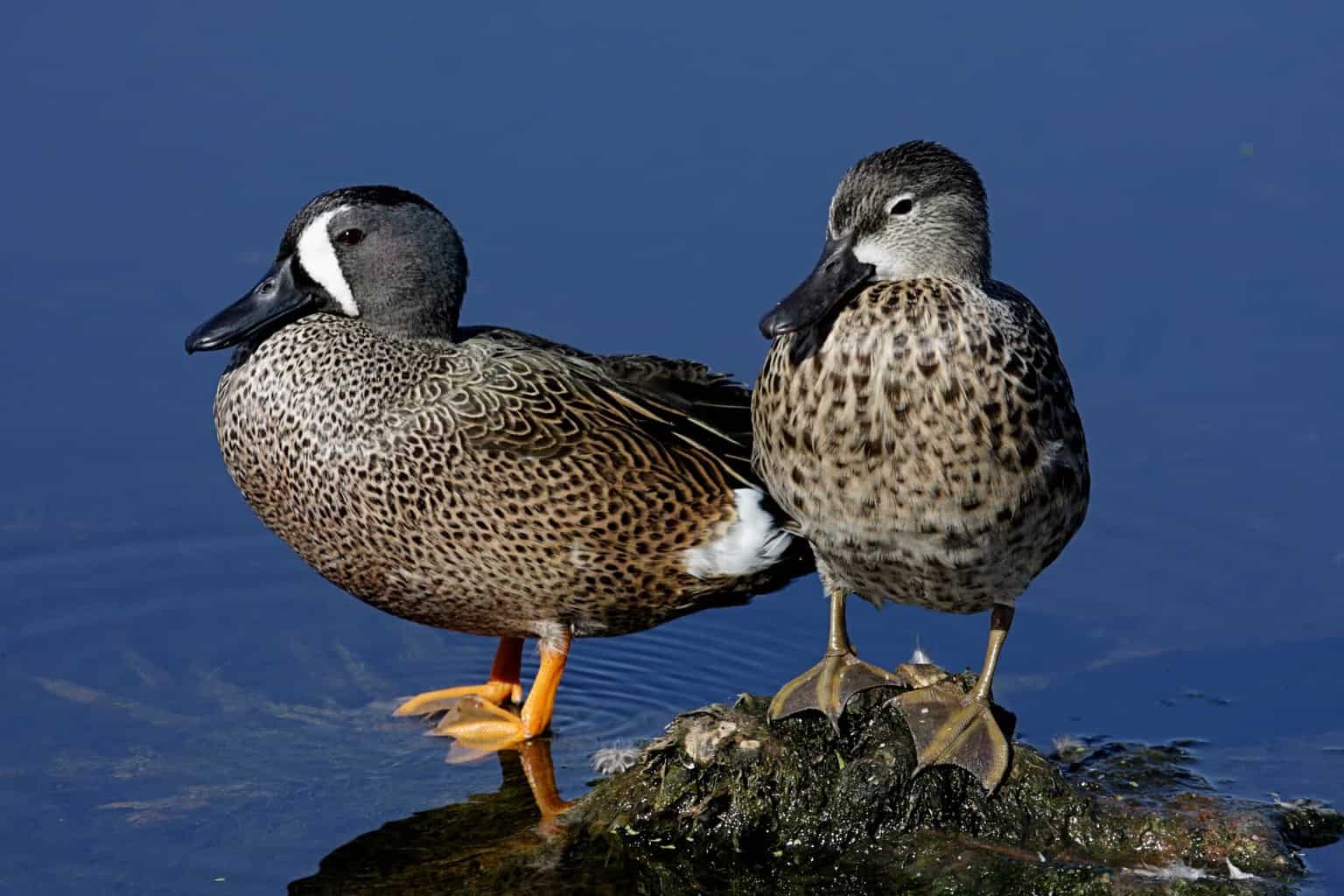
- Spatula discors
- Length: 14.2-16.1 inches
- Weight: 8.1-19.2 ounces
- Wingspan: 22.1-24.4 inches
Teal are one of the earliest migrants each year. According to the Virginia Department of Wildlife Resources, they start passing through the state in late August each year. And for most of them, they’re just passing through as they head further south.
Blue-winged teal are relatively small dabbling ducks that prefer calm waters such as marshes and ponds, so they can be found throughout the state while they’re on the migration path.
Females are unremarkably brown while on the water or the ground, with black bills and some slightly darker coloring on the cap and through the eyeline. When they take off, however, they reveal striking blue wing patches.
Males have the same powder blue wing patch that extends out into white and green. They have patterned brown bodies and slate blue faces that come to a signature white crescent just before the bill.
Green-winged Teal
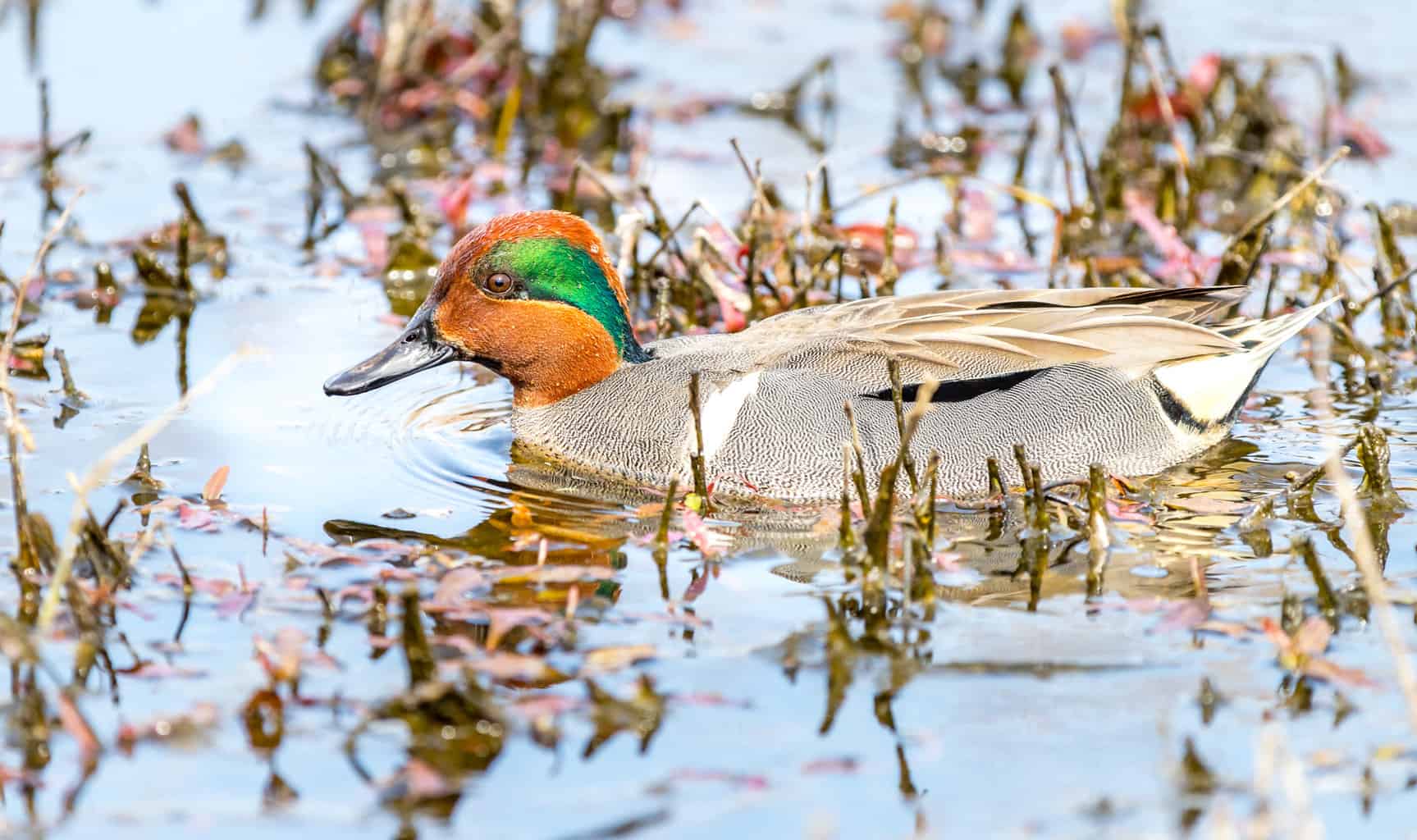
- Anas crecca
- Length: 12.2-15.3 inches
- Weight: 4.9-17.6 ounces
- Wingspan: 20.5-23.2 inches
Green-winged teal don’t start their migration quite as early as blue-winged teal do, and some winter in the state, according to the DWR.
Like blue-winged teal, they prefer shallower, smaller bodies of water, and it’s not uncommon to see these ducks, the smallest dabblers on our list, intermixed in groups of other birds.
Females are smaller than other similar species. They have brown bodies with a darker eyeline and cap, a black bill, and a small white patch near the tail. The namesake green wing patch doesn’t typically reveal itself unless the bird is flying, but once it takes off, that’s a good way to identify a female teal.
Males have grayish bodies and green wing patches, but the best way to identify them is by their chestnut brown heads and the thick green band that begins at the eye and runs toward the back of the head.
They also have one lightly-colored stripe on both sides of the body that runs vertically along their side.
American Wigeon

- Mareca americana
- Length: 16.5-23.2 inches
- Weight: 19.1-46.9 ounces
- Wingspan: 33.1 inches
American wigeons breed north and west of the Great Plains, moving south and to coastal states for winter each year.
They can be seen around saltwater as well as freshwater habitats like lakes, ponds, marshes, and rivers across the rest of the state from the fall to spring.
Males have rusty brown sides and a signature white head cap flanked by green stripes extending from the eyes backward. In flight, they have white and green wing patches.
Females are tan brown overall with heads of grayish-brown. Around the eye, they have a darker color pattern. Both males and females have light gray bills with black tips.
Eurasian Wigeon
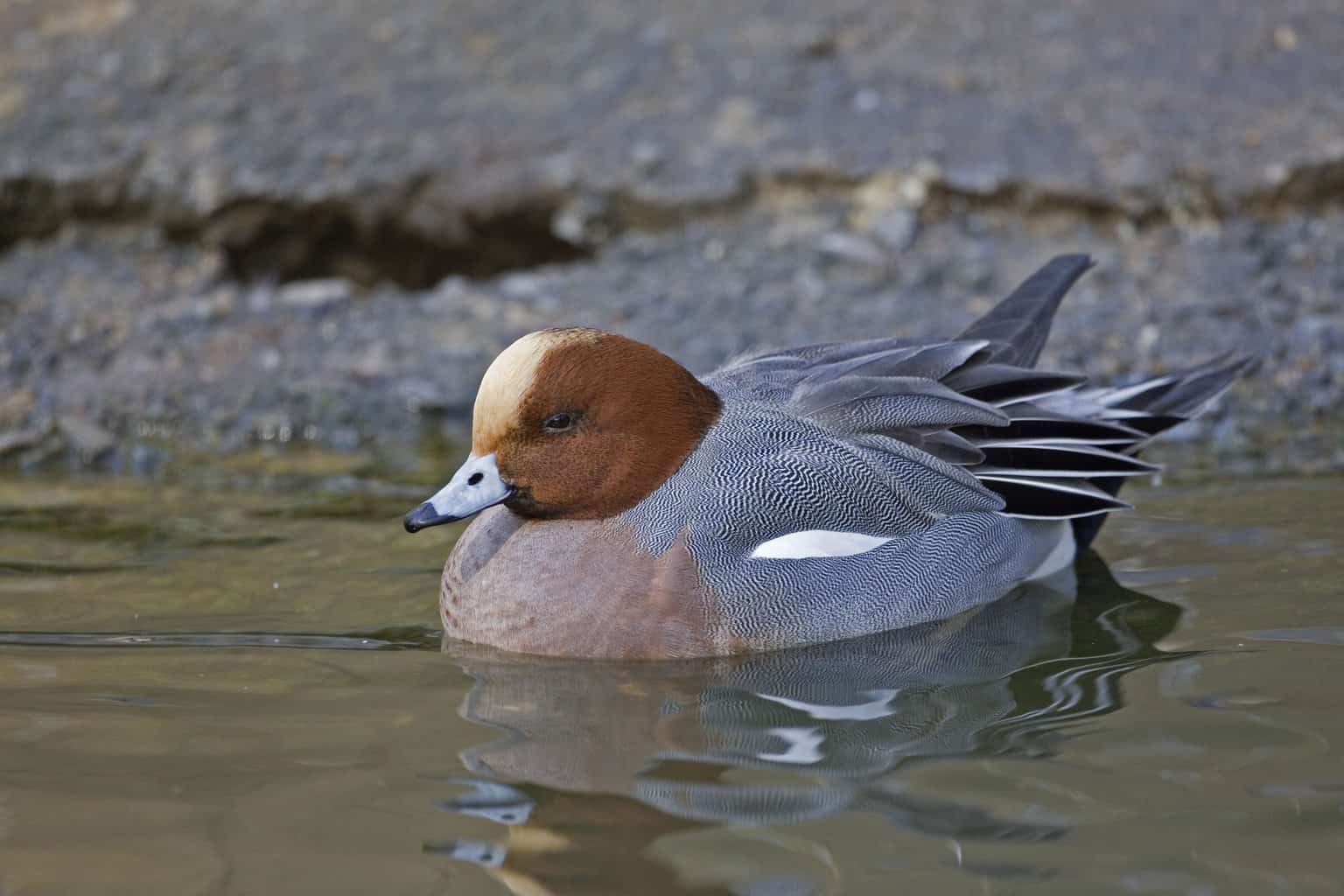
- Mareca penelope
- Length: 17.7-22.8 inches
- Weight: 14.6-34.2 ounces
- Wingspan: 29.5-33.9 inches
(Measurements courtesy of the University of Michigan’s BioKids)
Eurasian wigeons have a spotty winter range in North America, where they are annual but rare visitors from their breeding range across the ocean.
Your best chance to see one is near the coast, but it’s still very rare. In the 2022-23 winter, eBird users reported sightings in just a handful of publicly accessible locations like near Hoffler Creek Wildlife Preserve and Chincoteague National Wildlife Refuge along the coast and McCormick’s Mills out by Raphine in western Virginia.
If you’re looking to add the Eurasian wigeon to your life list, it’s best to check in with a local birding group or eBird regularly so you can be on top of it when one is spotted in Virginia.
Look for a mostly gray male with an all-chestnut head, as well as a gray bill tipped in black, similar to the American wigeon. Females look similar in both shape and pattern as well but with a red-brown body to the American wigeon’s tan.
Northern Pintail
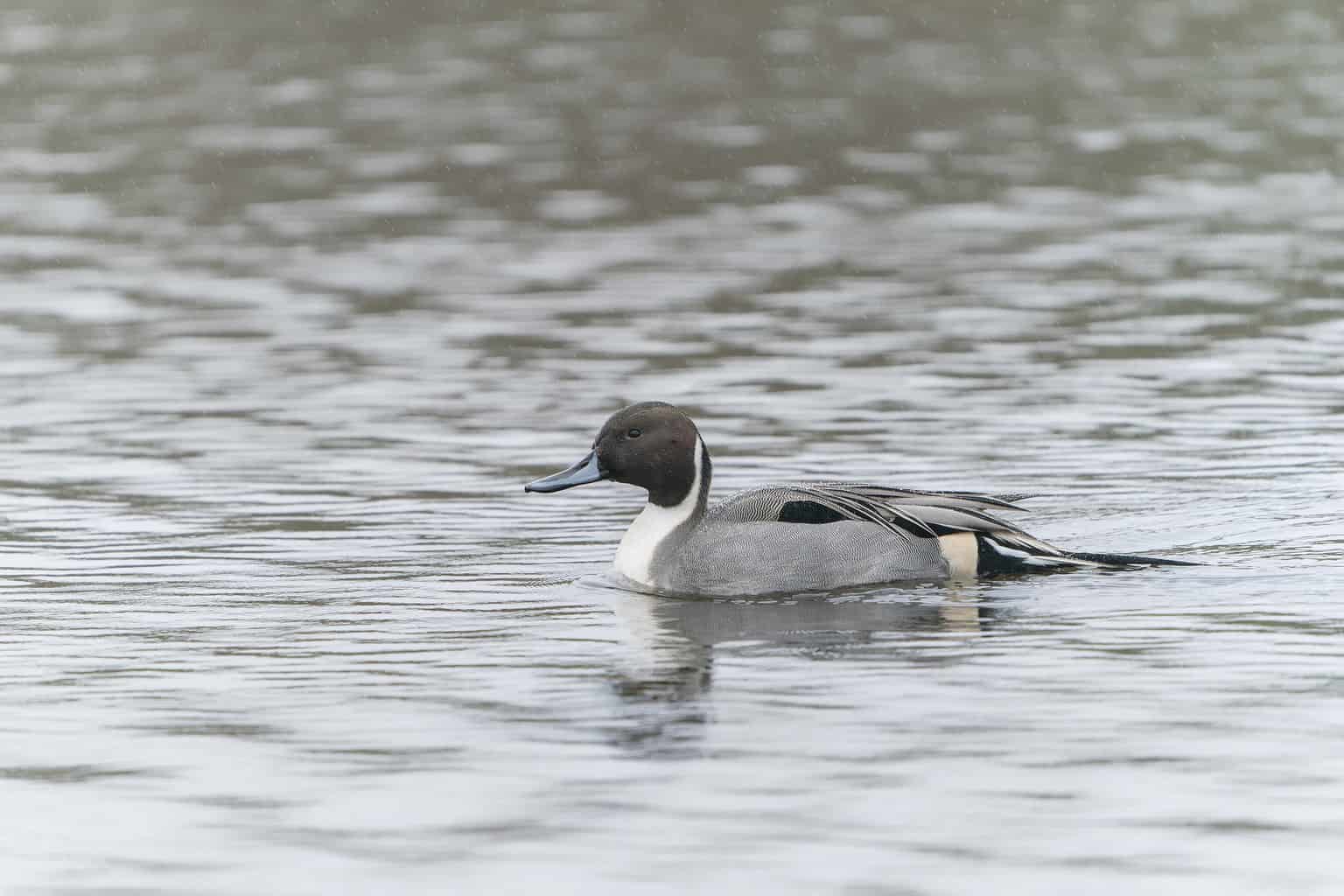
- Anas acuta
- Length: 20.1-29.9 inches
- Weight: 17.6-51.1 ounces
- Wingspan: 34 inches
Northern pintails are not the most commonly reported duck in Virginia, but they are regular winter visitors to the state, where they take up residence in marshes, bays, lakes, and ponds.
Male pintails are unmistakable, from their long necks and chocolate brown heads to their long, thin tails.
Females’ tails are longer than the average dabbling duck female, but not to the extent of the male. Their long necks stick out in a crowd if extended. While stationary, their neck might tuck in, making it more difficult to tell them apart. They have plain faces and black bills, with bodies of a similar pattern to other closely related ducks.
Wood Duck
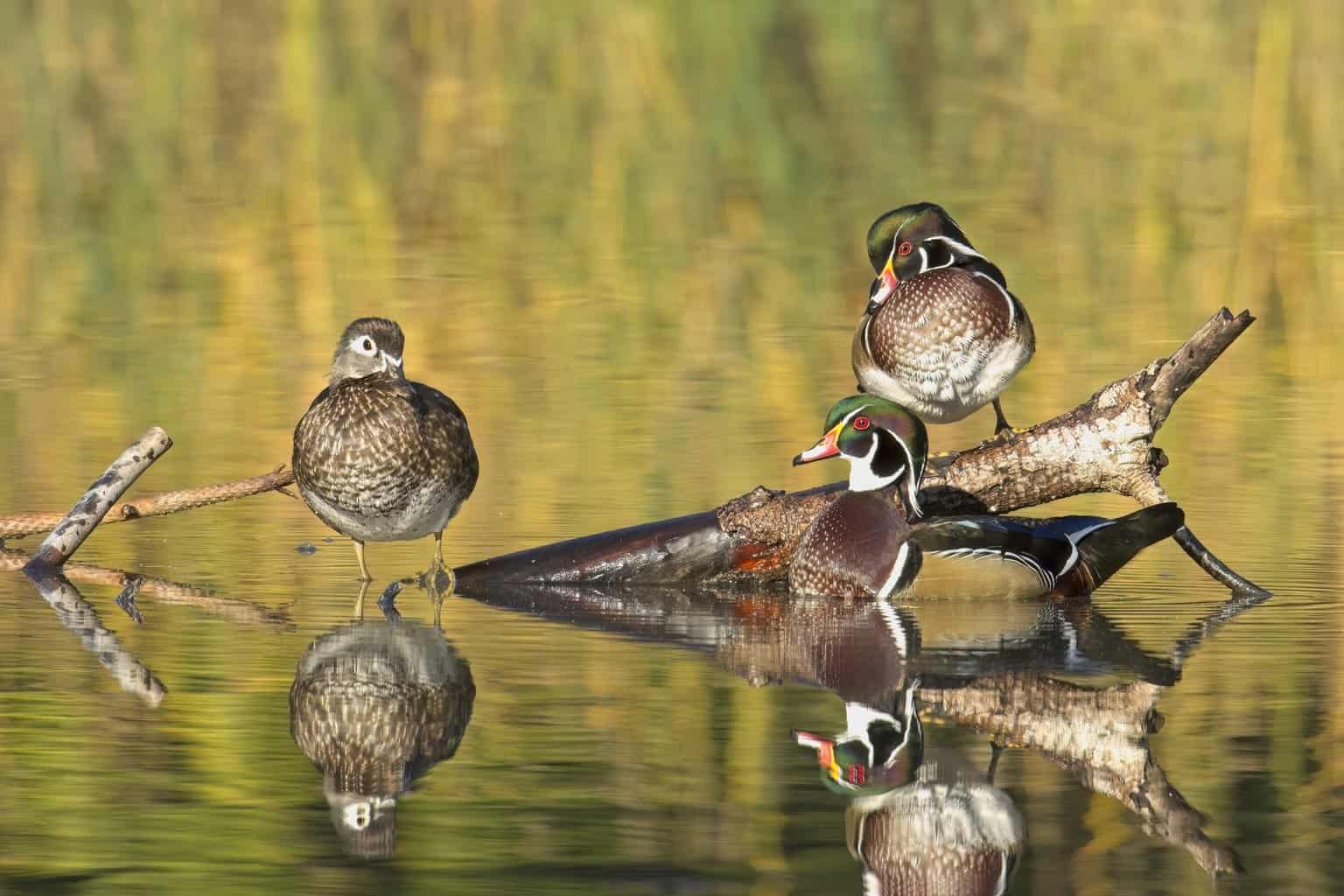
- Aix sponsa
- Length: 18.5-21.3 inches
- Weight: 16-30.4 ounces
- Wingspan: 26-28.7 inches
Wood ducks are typically seen in more wooded, less open areas than many other duck species.
They are widespread and common across much of the eastern United States, where they nest in tree cavities along wooded rivers, streams, lakes, and ponds.
Drakes have shiny green crested heads adorned with white markings, as well as a signature brown chest. From its tan sides up to its face, the male wood duck is covered in crisp markings and patterns.
Females are a bit less flashy. Their crested heads are a grayish tan, with dark eyes surrounded by a white ring.
They have dark blue and white markings along the wing that can be seen when on the ground and in flight.

